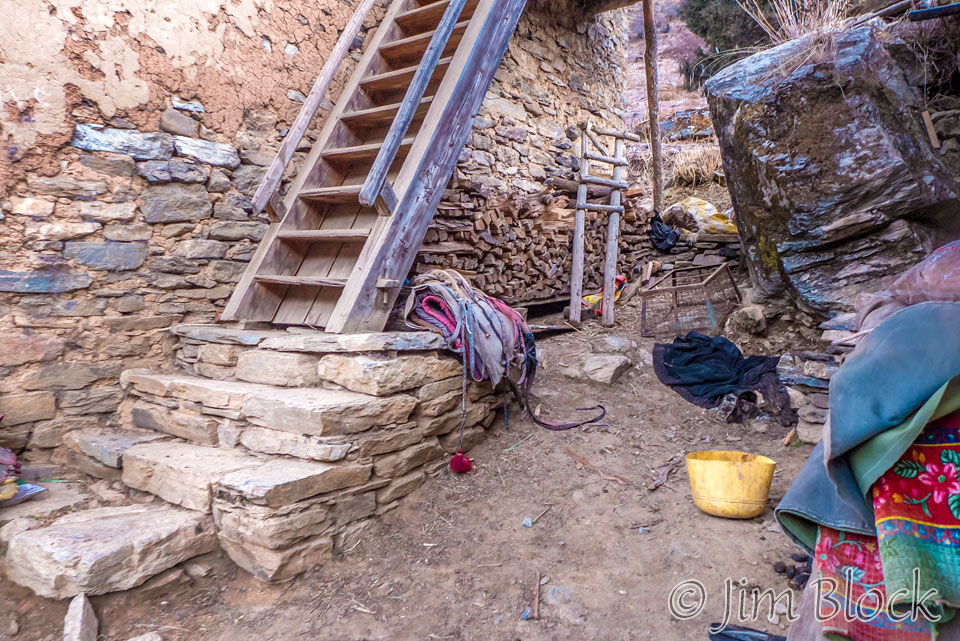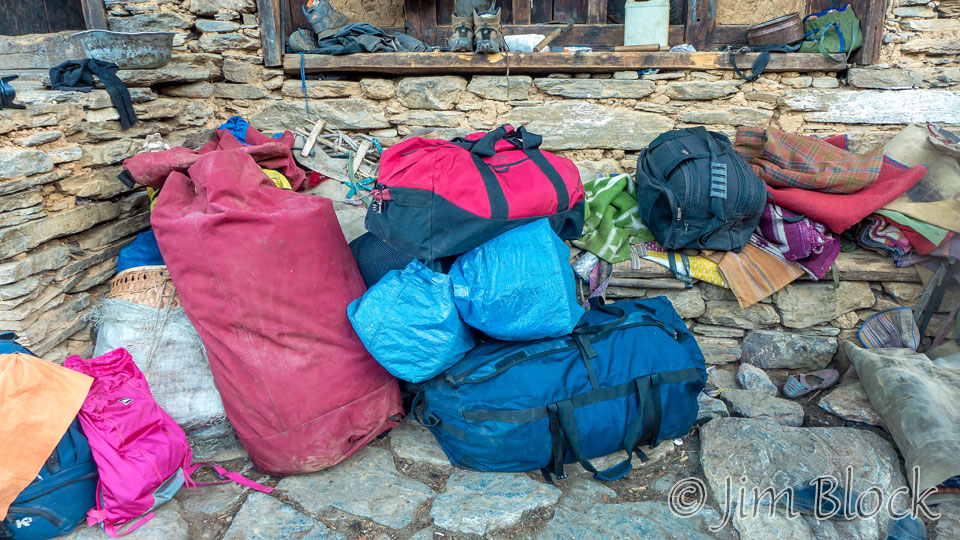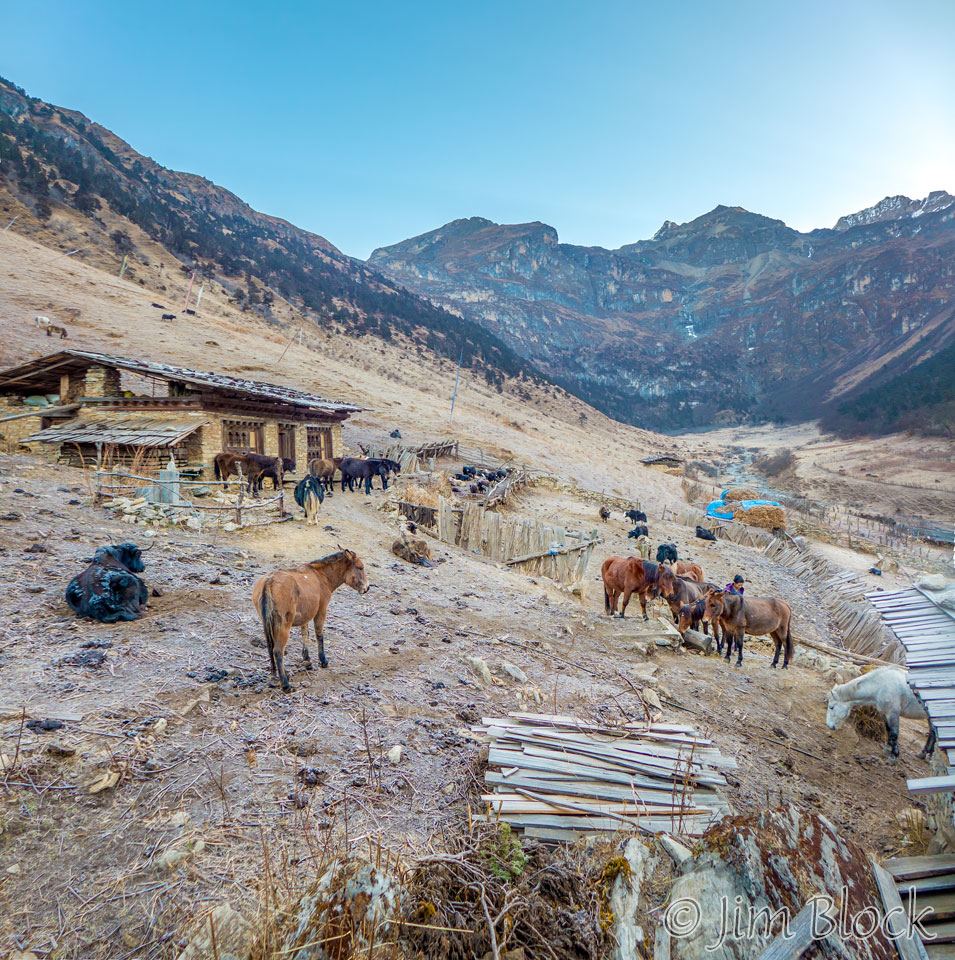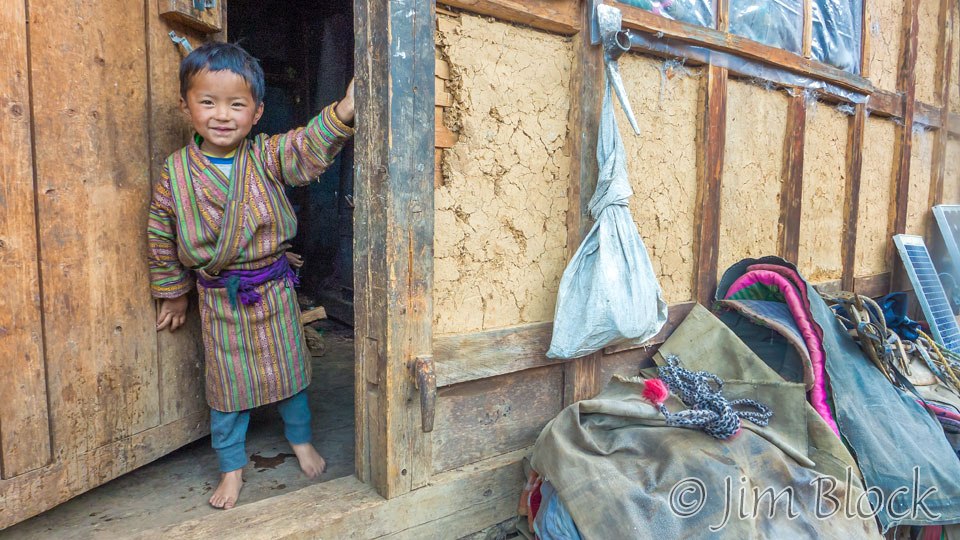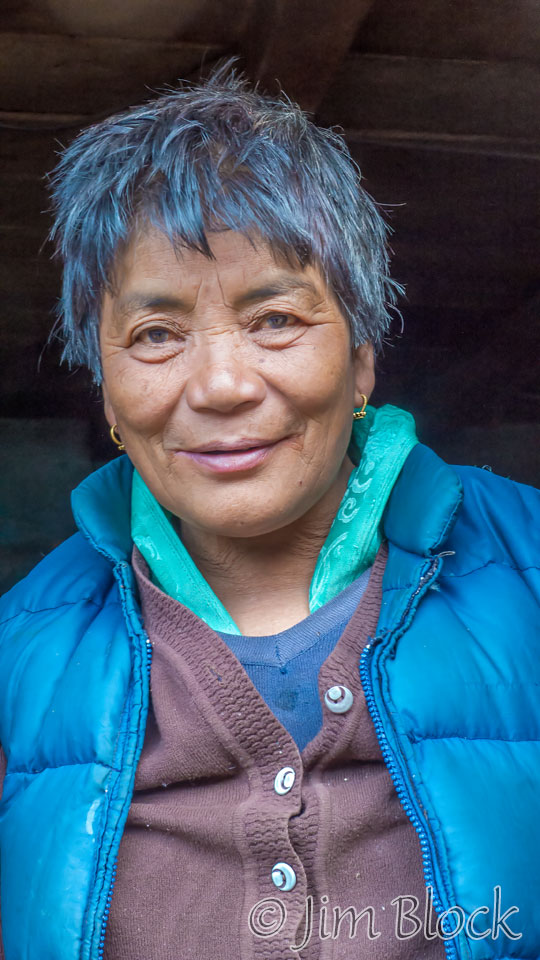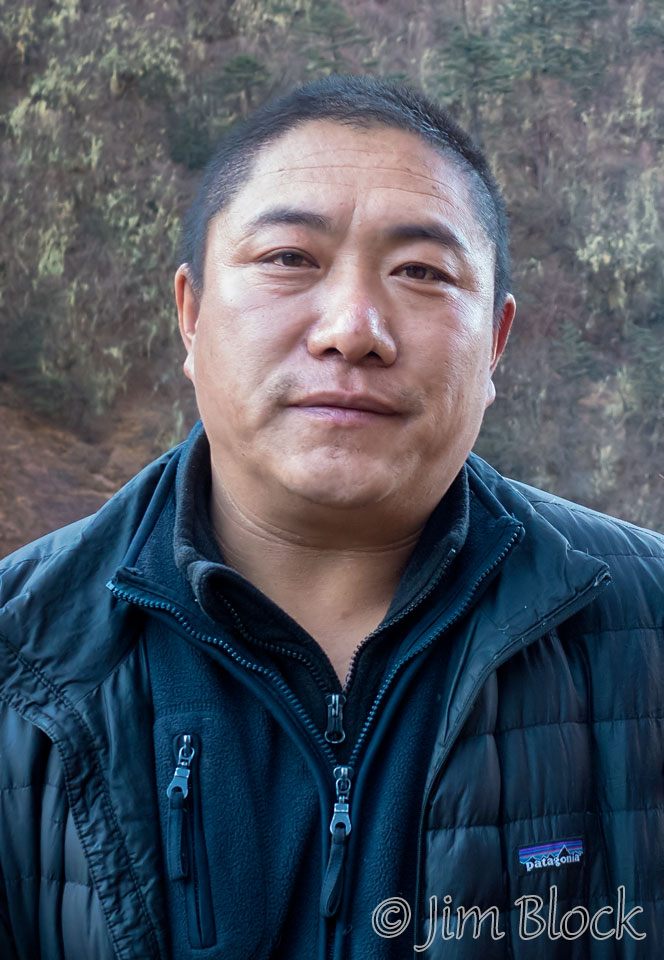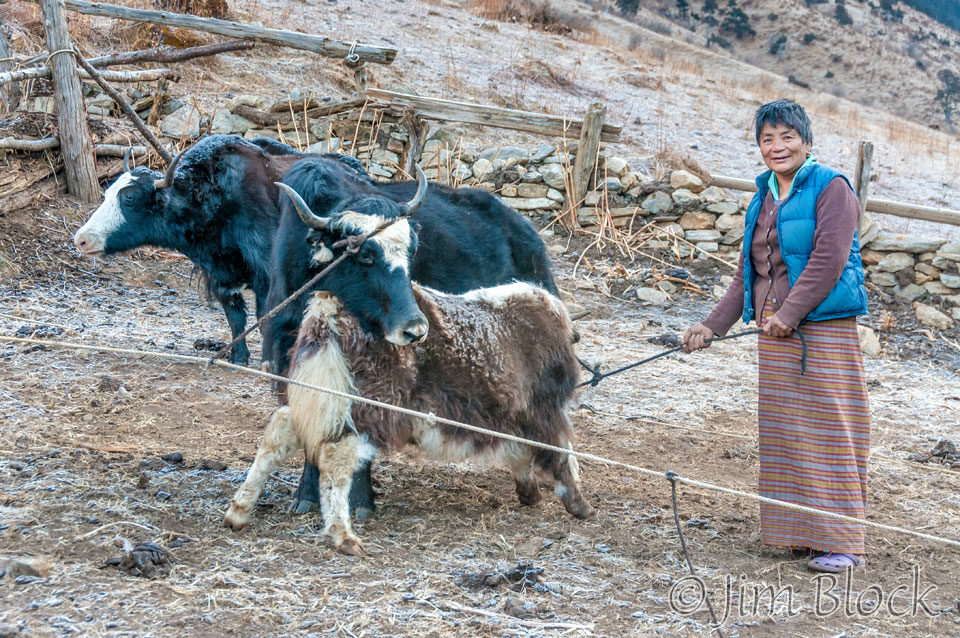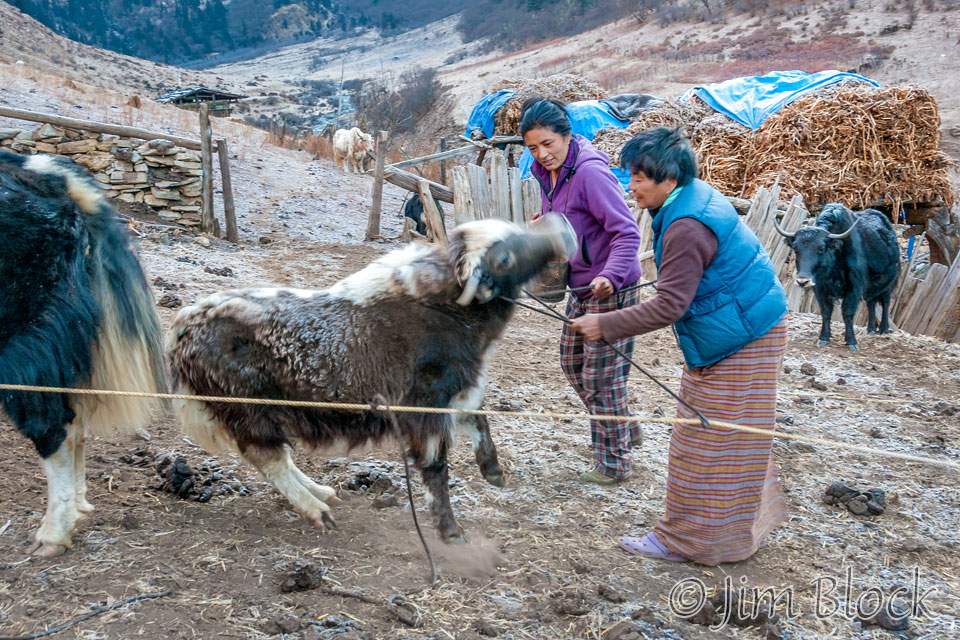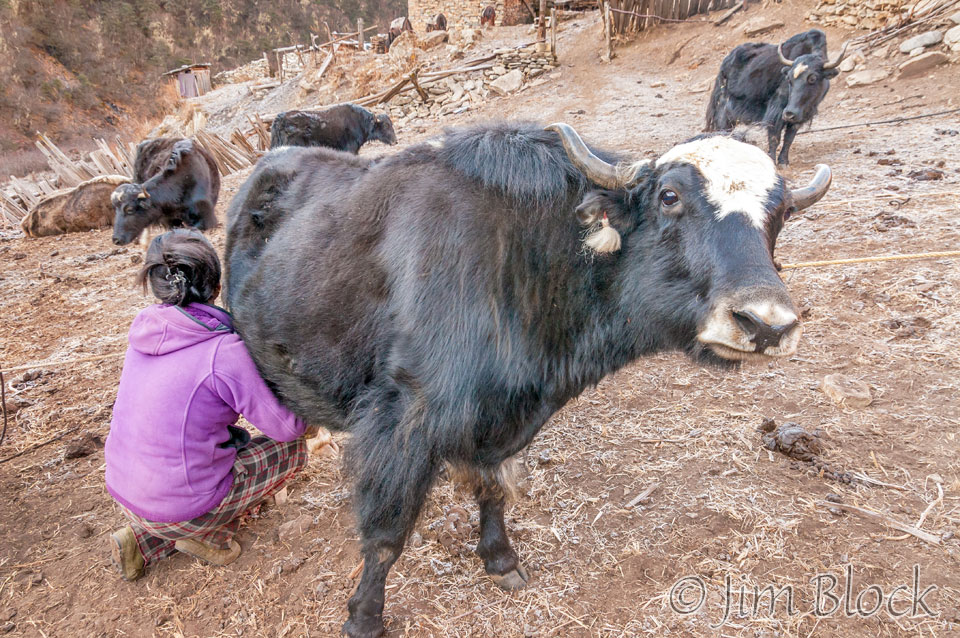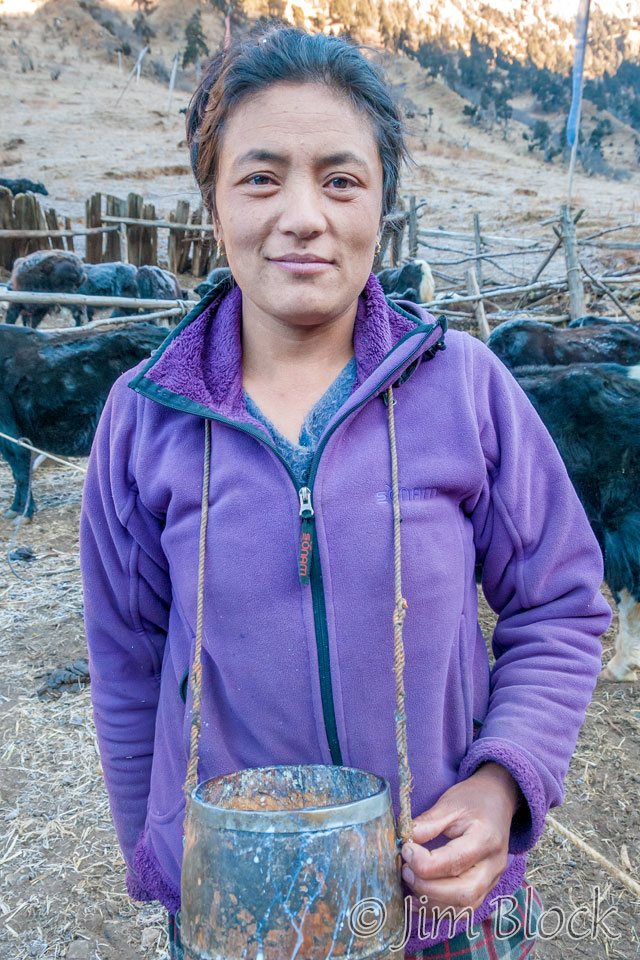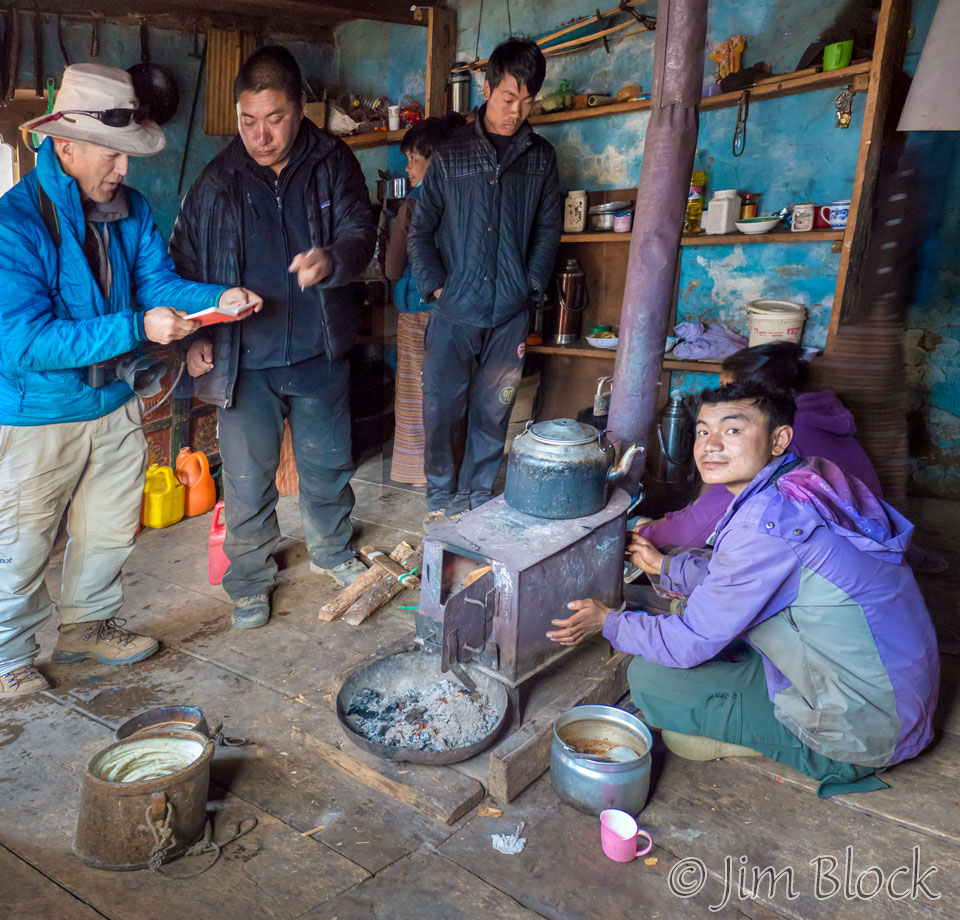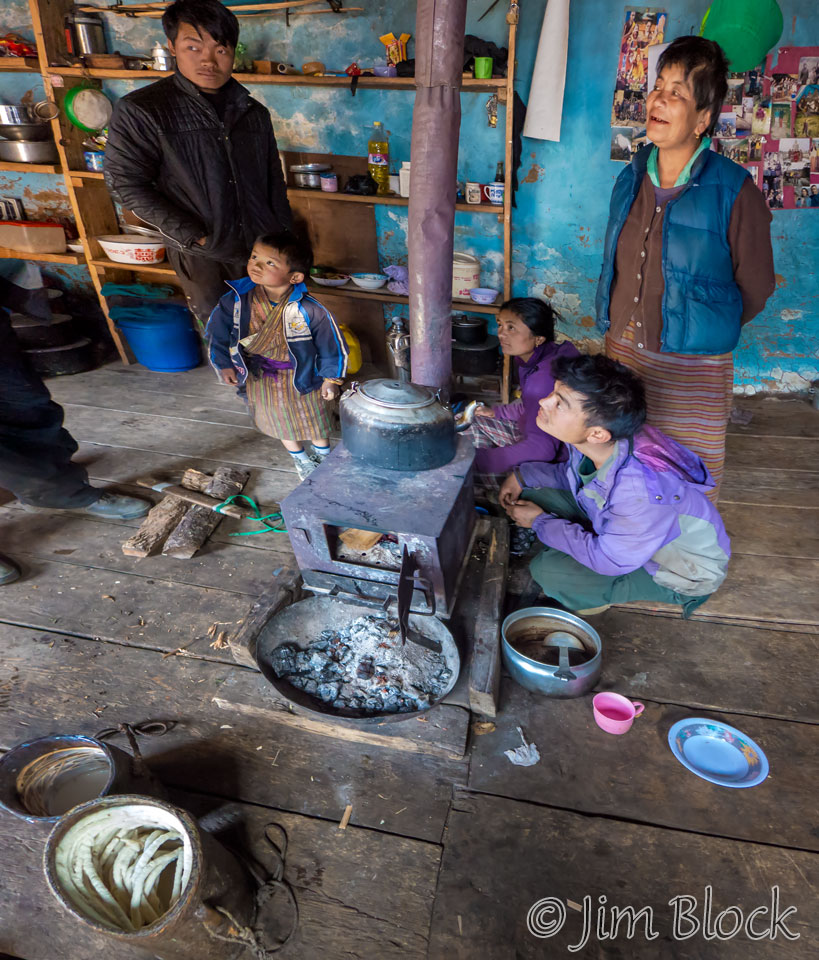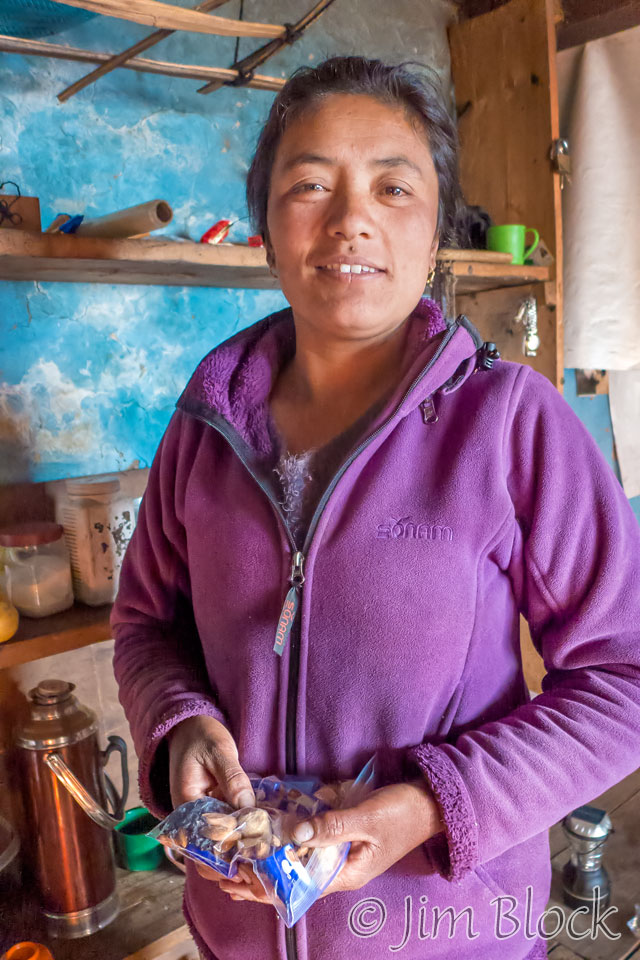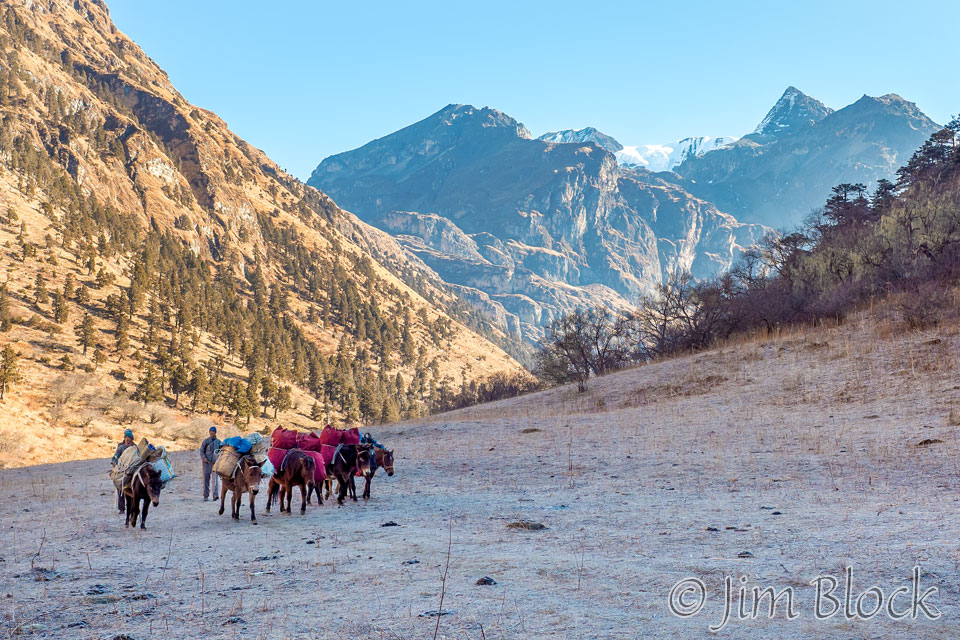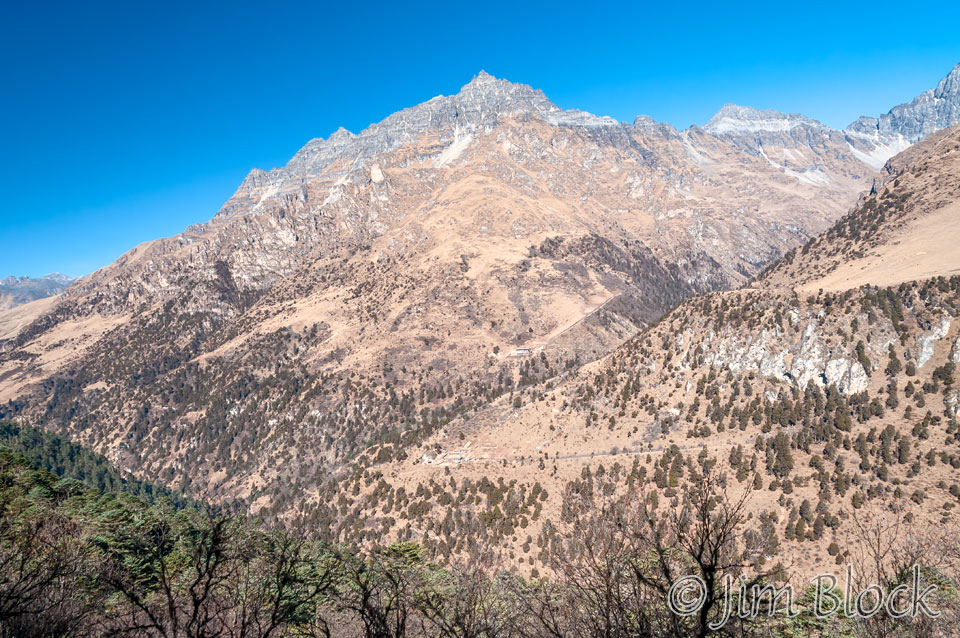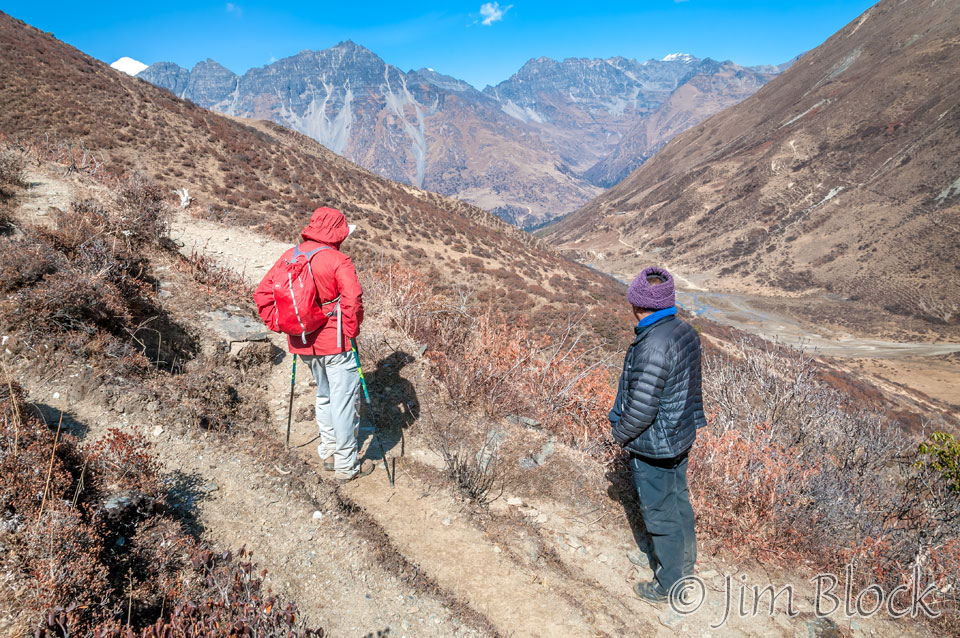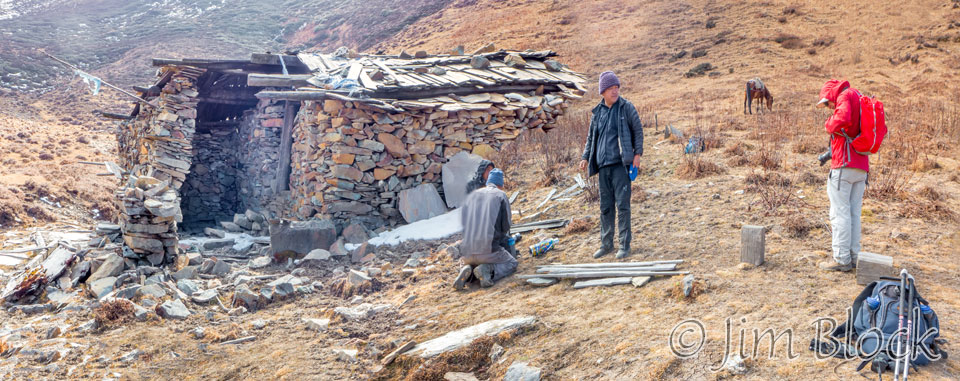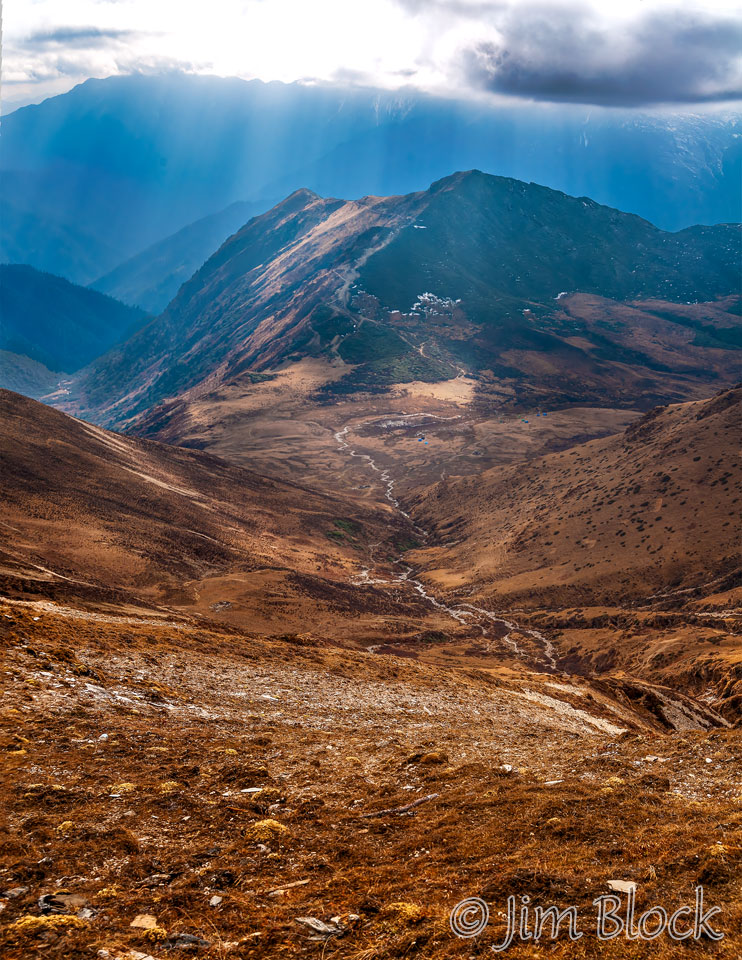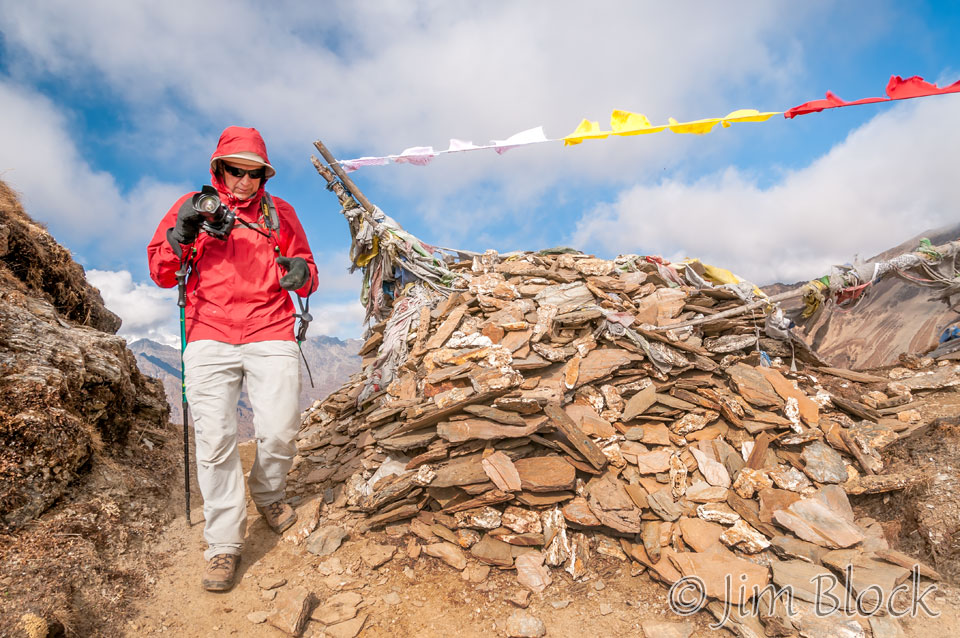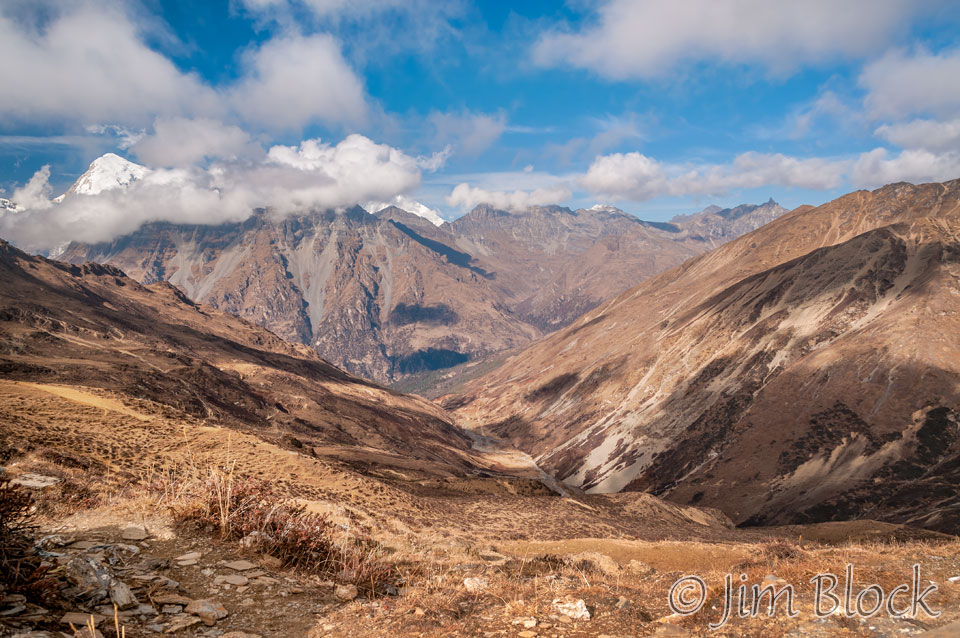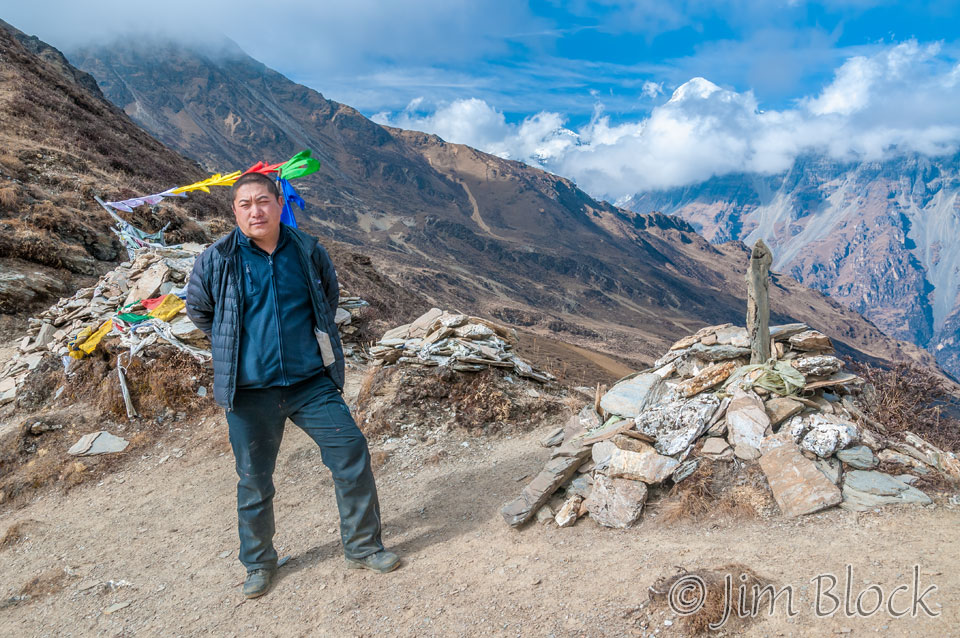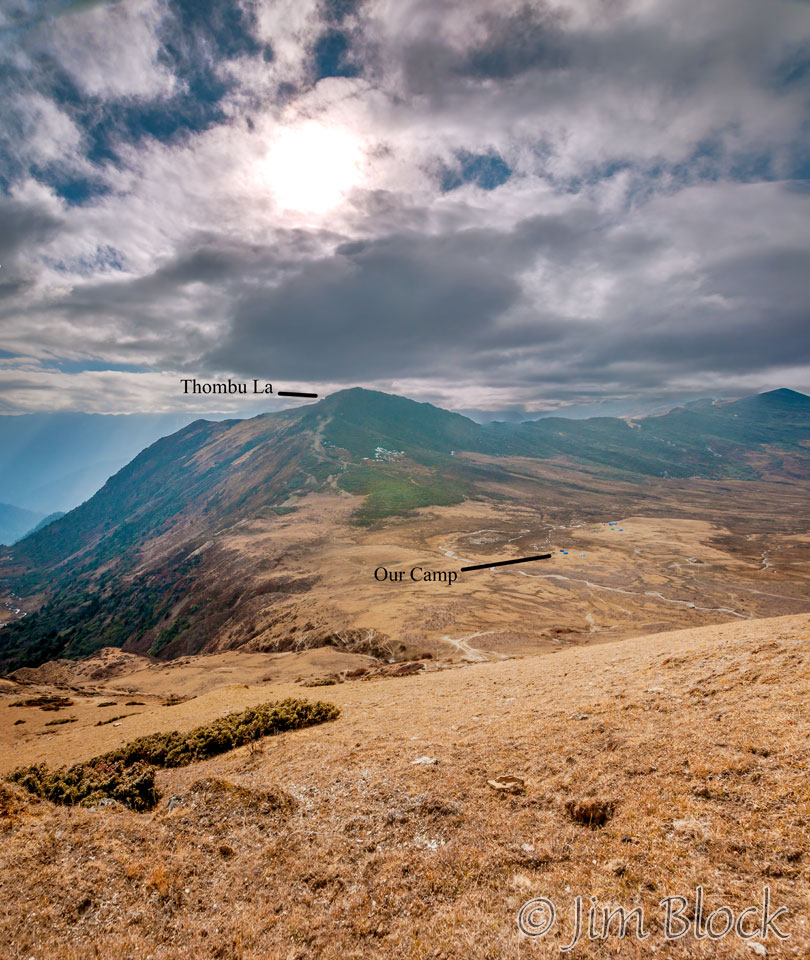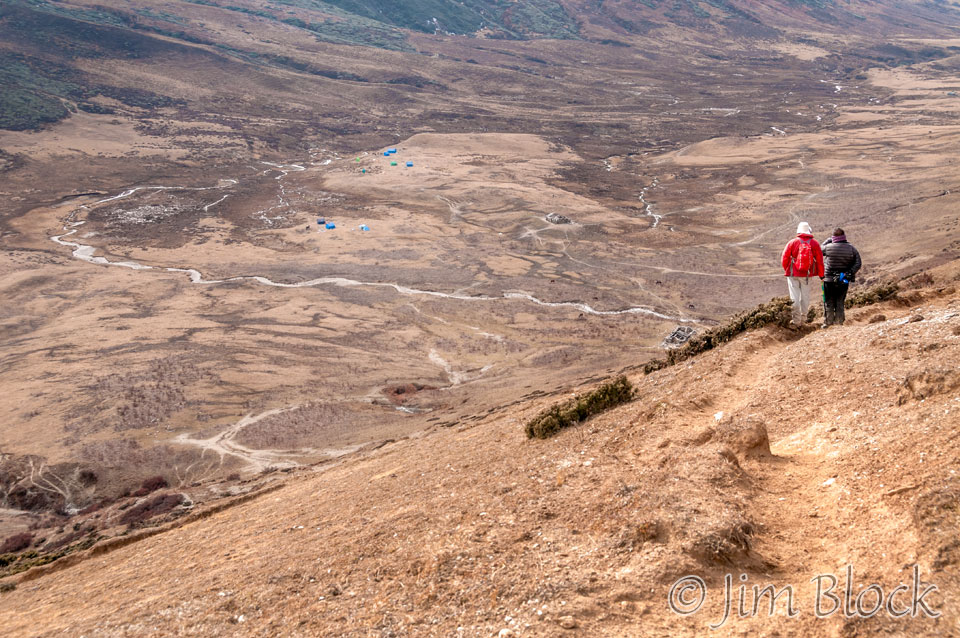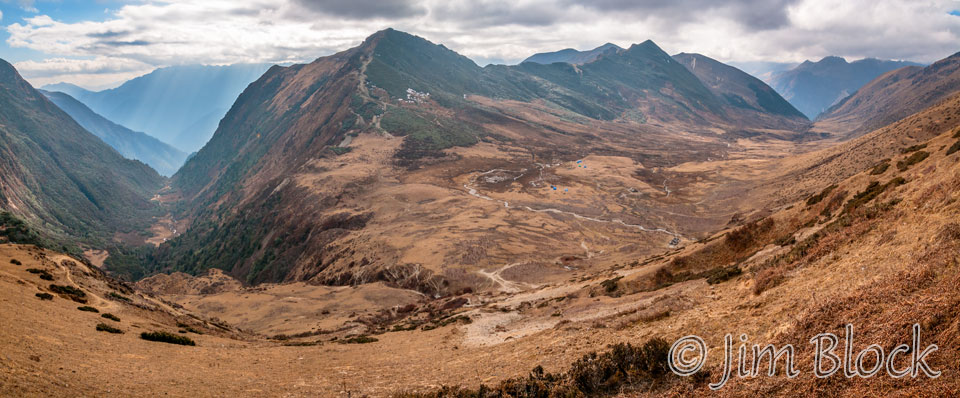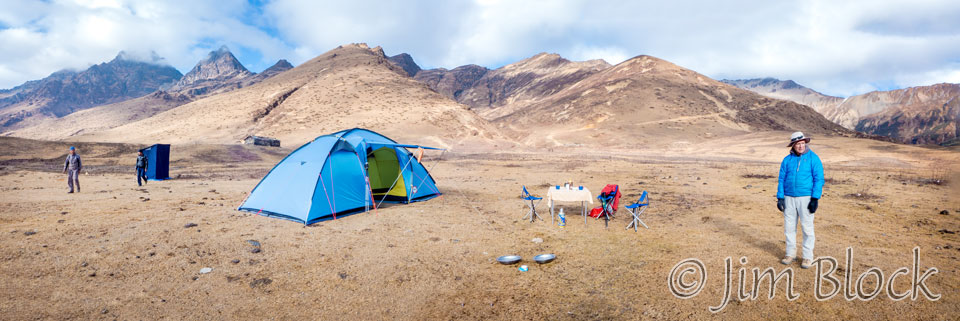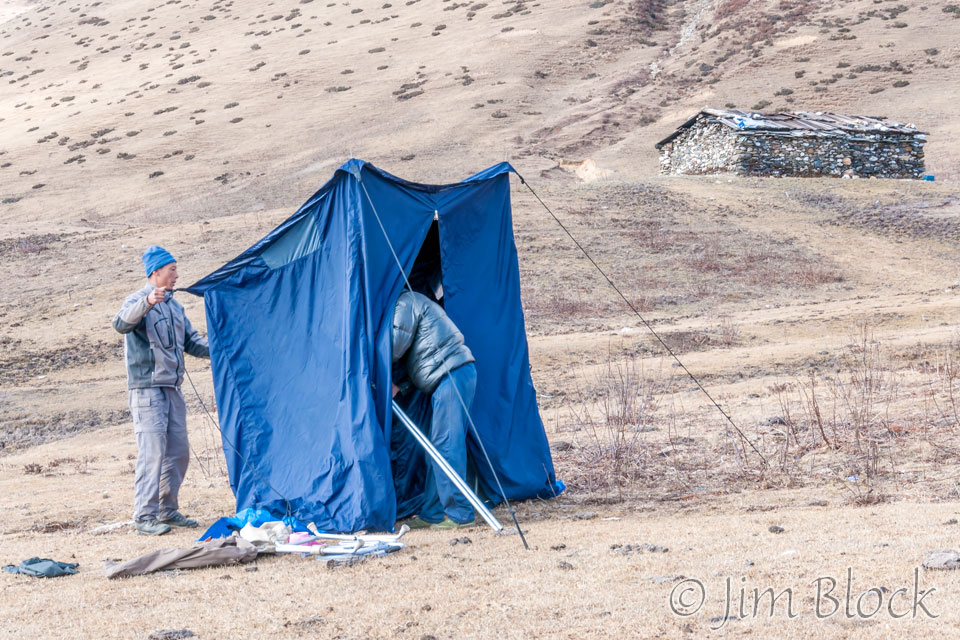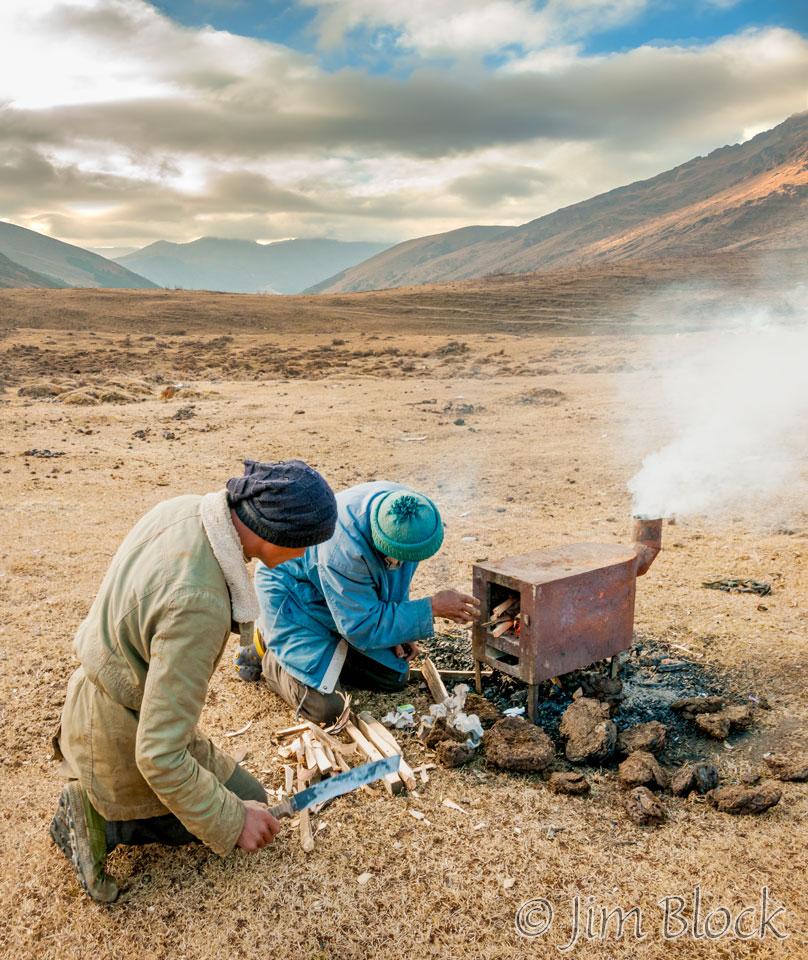 The fifth day of our trek started at a nomad house and ended in a beautiful valley over another high pass. But before we started hiking, the morning held several adventures and learning experiences. Staying overnight with the nomad family was an experience I will always remember and cherish. Thank you, Phub.
The fifth day of our trek started at a nomad house and ended in a beautiful valley over another high pass. But before we started hiking, the morning held several adventures and learning experiences. Staying overnight with the nomad family was an experience I will always remember and cherish. Thank you, Phub.
I awoke at 6 AM, but breakfast would be late today, not until 7:30. We would depart at 8:30. Only six and a half hours of trekking today, an easier day than yesterday. The last few mornings I had a mild “Khumbu cough”, a dry cough that seems to come at high altitude and is named after the region in Nepal near Mount Everest.
Before I left our bedroom I made a shaky photo of my bed and gear. You can see the very comfortable blue pad we had on the trek with a hot water bottle on it. You can probably make out my shoes. Next to them is the all-important camera bungie, and below them in the photo a camera battery and a headlamp on the rug.
Bright and early, the horses were waiting to be fed.
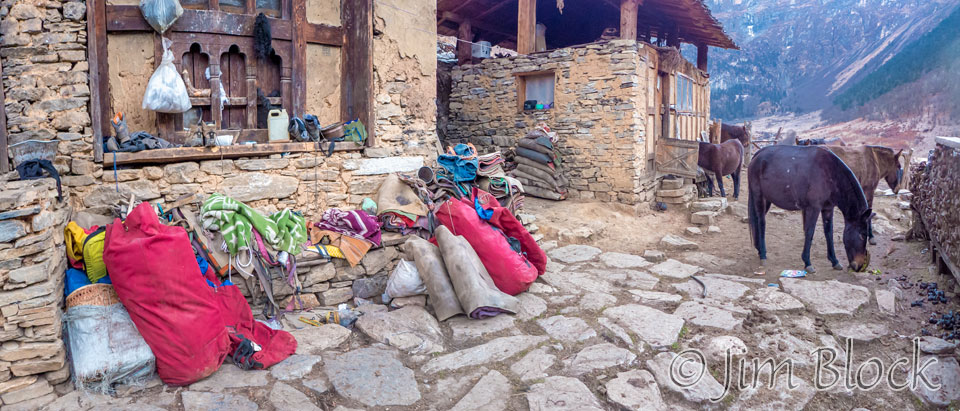
We were always given a pan of hot water to wash with before meals. The family had a constantly-running outdoor water source. You can see the toilet in the background, behind the horse.
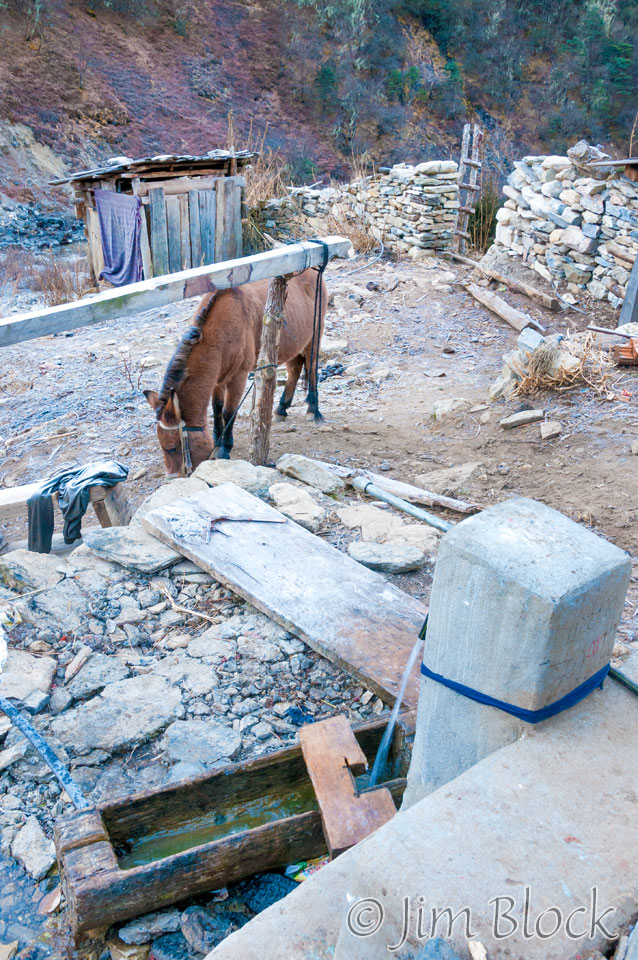
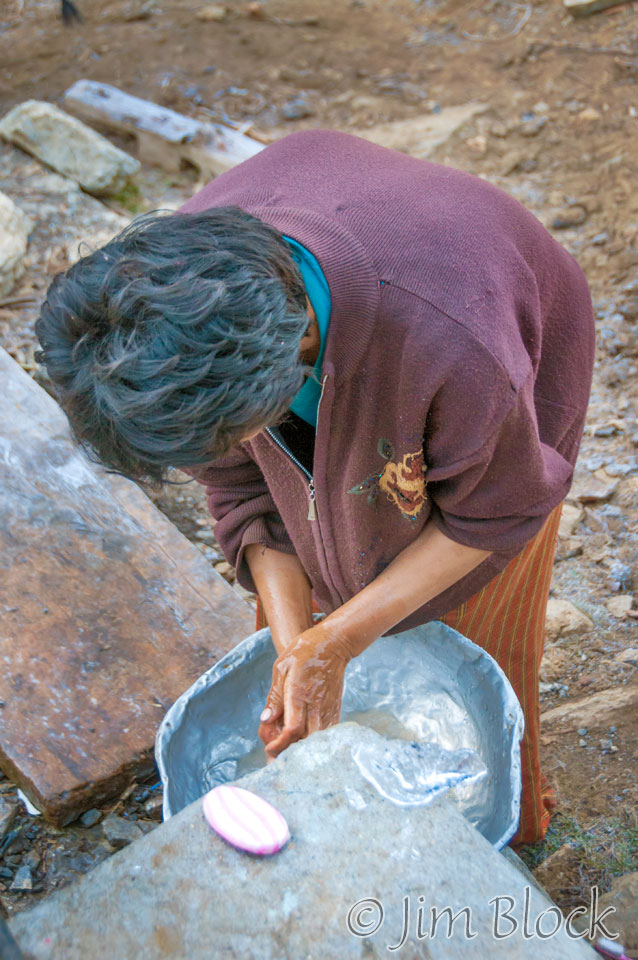
We enjoyed another great breakfast — an omelet, bread cooked in ghee, porridge, juice, spam (!), and the usual (for Nepal and Bhutan) instant coffee. In case you aren’t familiar with ghee, our ghee was made from raw yak milk, boiled, cooled to around 40-45 °C, and then curd cultures were added. It was covered at room temperature for at least 12 hours, then the curd was churned to obtain cultured butter. This butter was finally used to simmer into ghee and served on our bread. As I said before, we ate better on the trek than in most restaurants in Bhutan, except the several Dhamey personally took us to.
There was some frost on the yaks as they waited to be milked and let out to pasture.
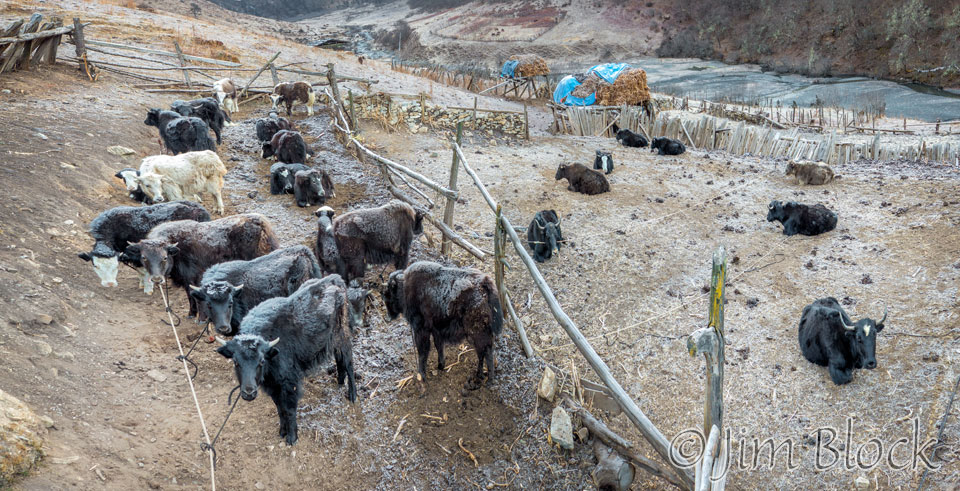
Our horseman fed the horses and the young boy posed for more photos.
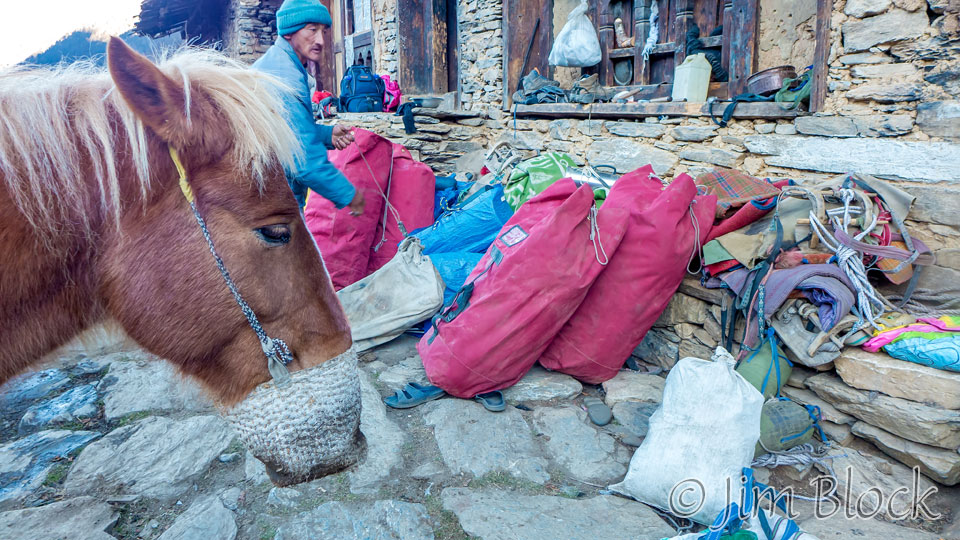
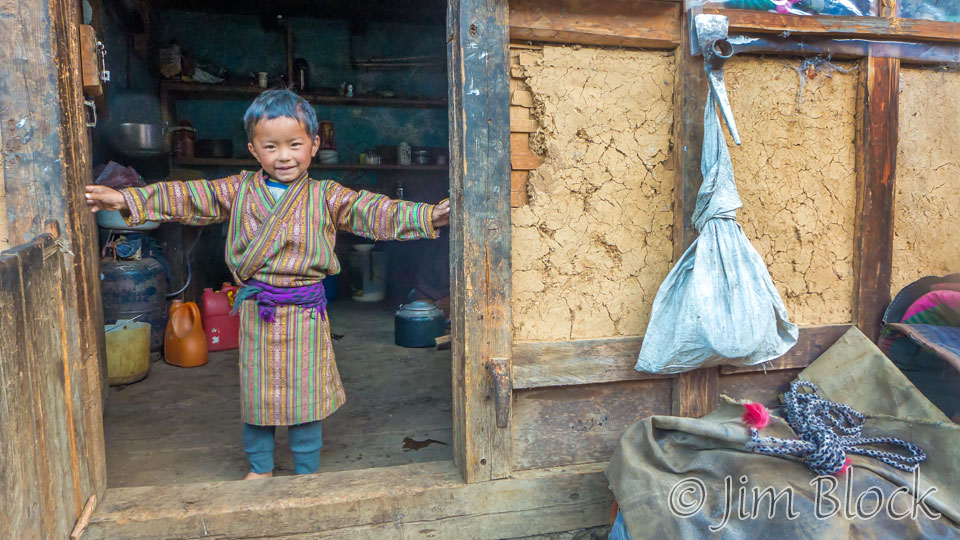
Phub posed for a photo with his good friend from the family.
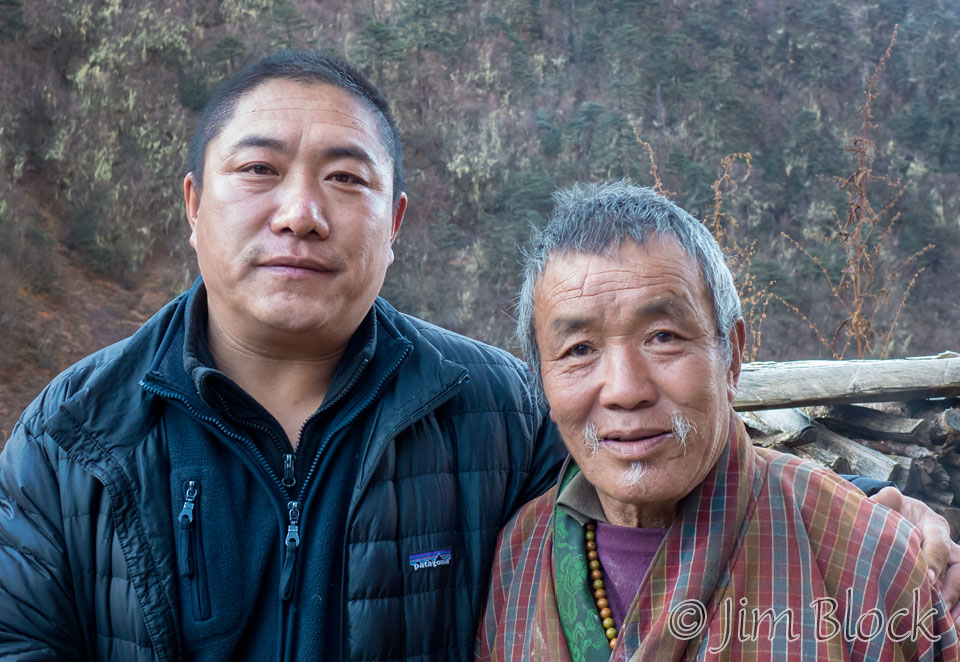
Because we had to leave early, the two woman did a special early yak milking for our benefit. They brought a calf in to get the mother (nak) started then had to drag the calf away to get the milk.
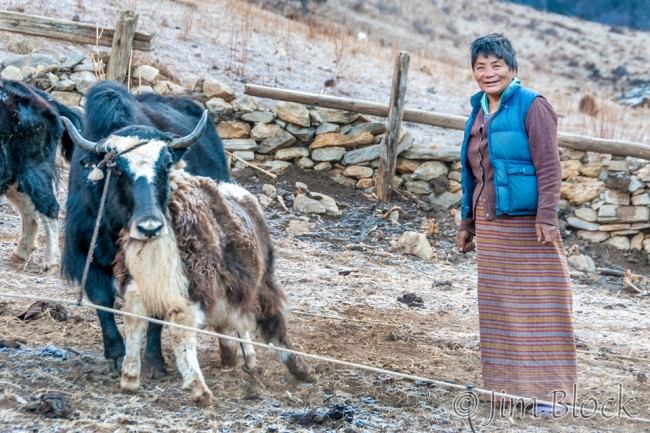
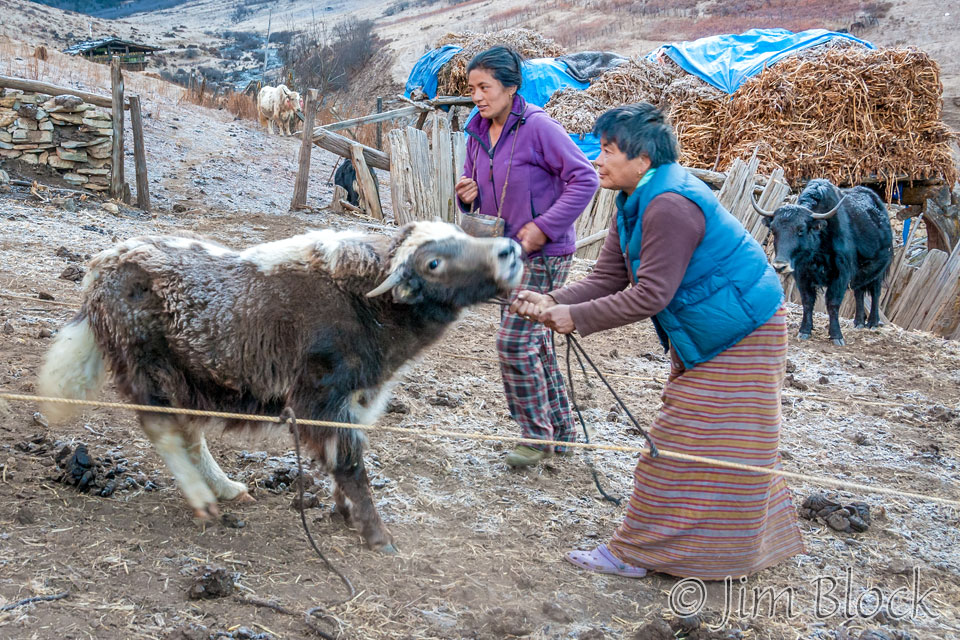
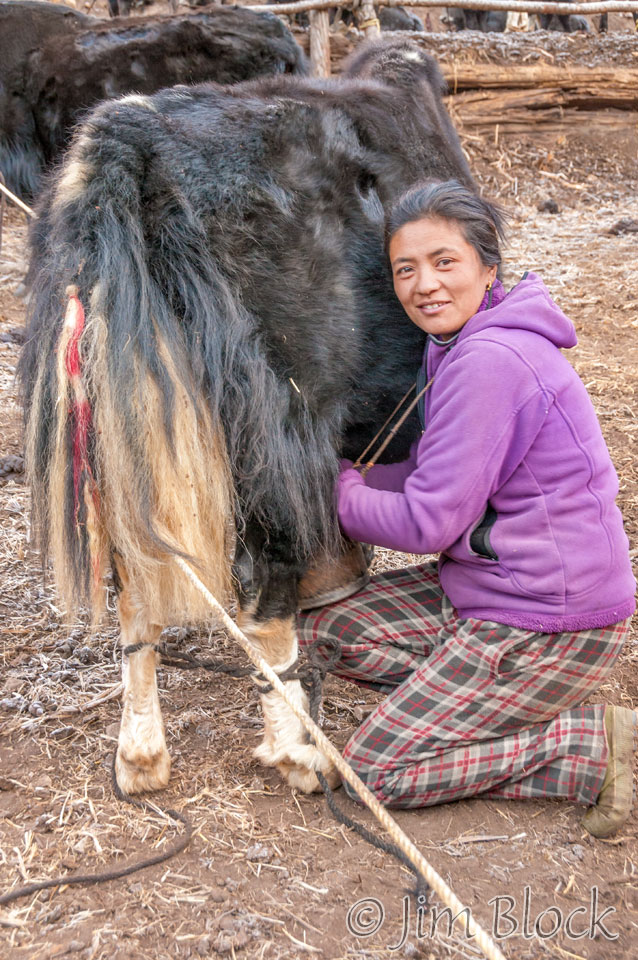
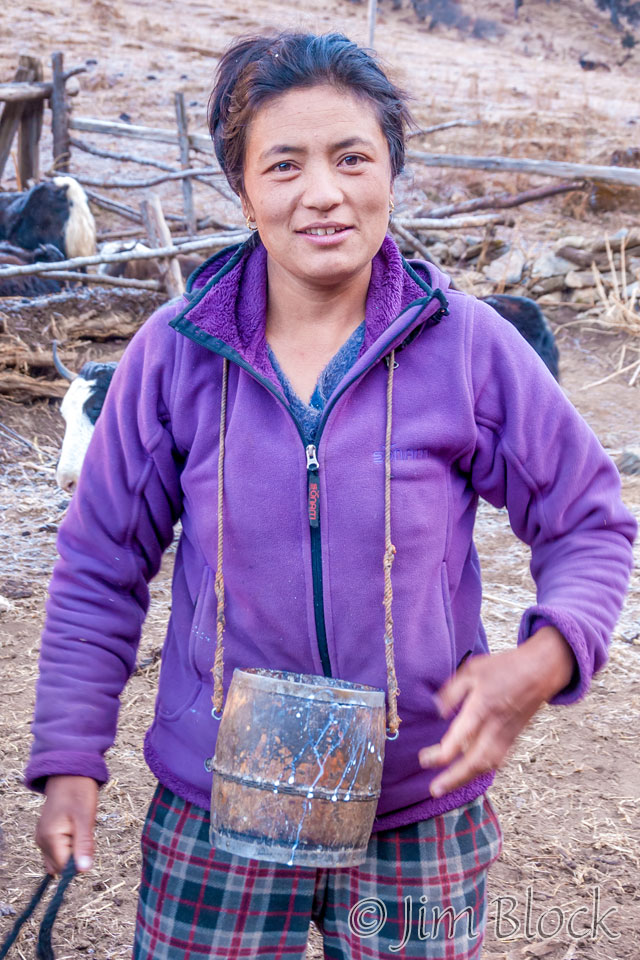
There was straw in the milk pail. Why? After more than 100 milkings the covering on the straw is a delicacy which is eaten right off the straw.

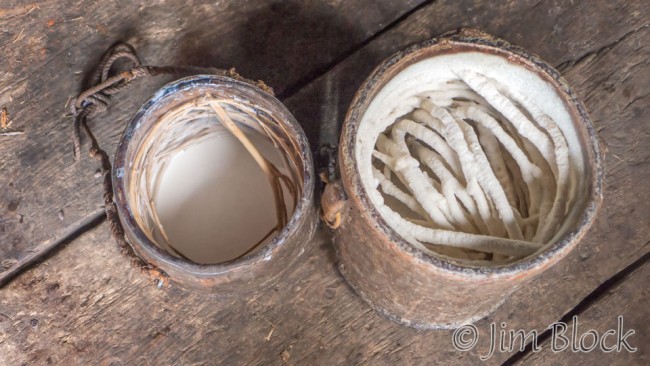
The afternoon before our trek when we visited Dhamey and Sonam in their home, Sonam gave each of us a bag of treats — nuts, chocolate and dried fruit. Since we were so well fed on the trek, I had barely touched my bag. As a thank you, I gave my bag to the nomads. The young boy immediately enjoyed a rare chocolate.
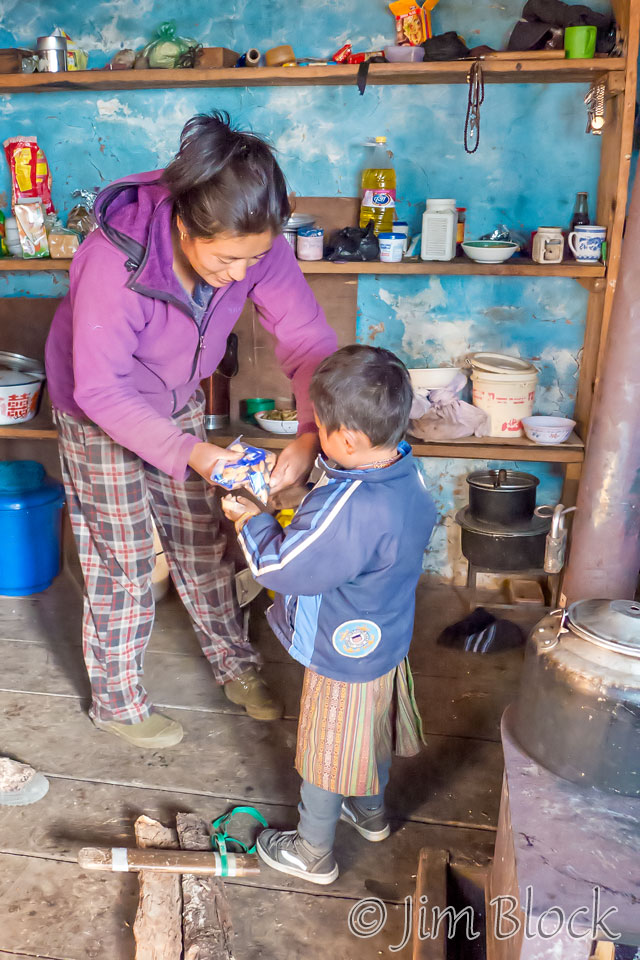
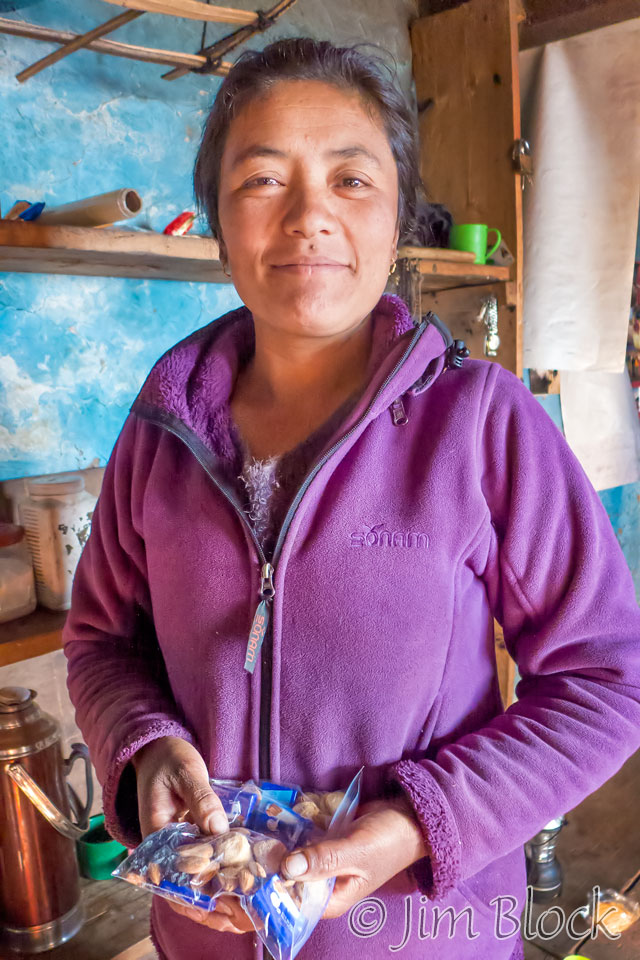
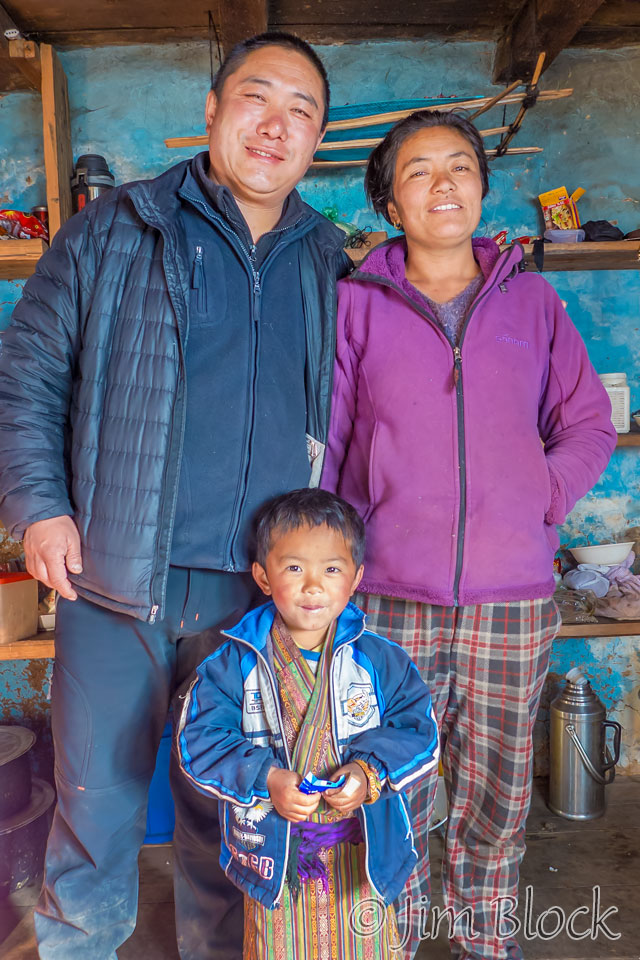
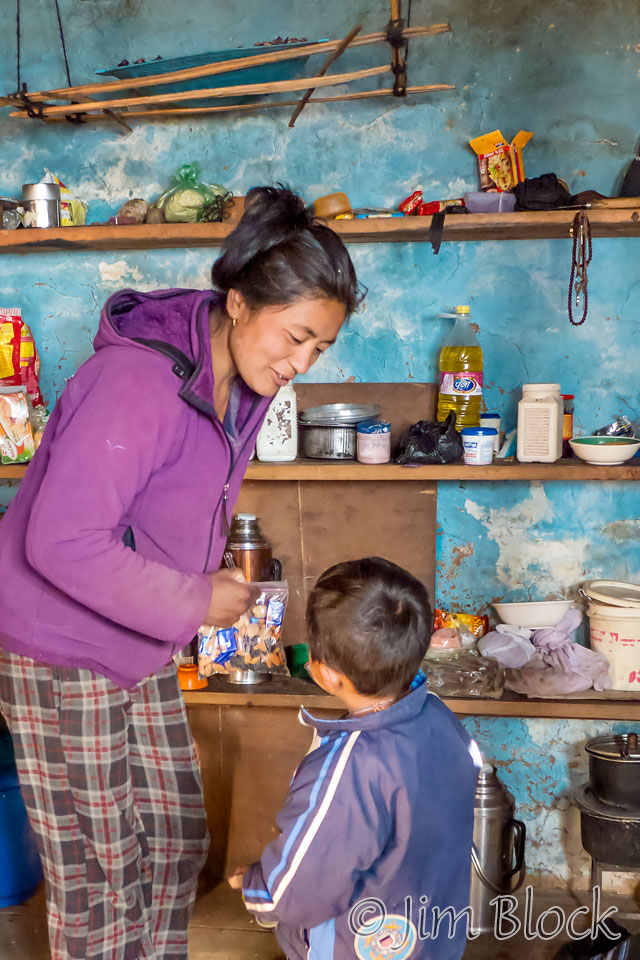
Before we departed we made some family portraits. I hope Phub will find a way to get these to them, or ask me for prints.
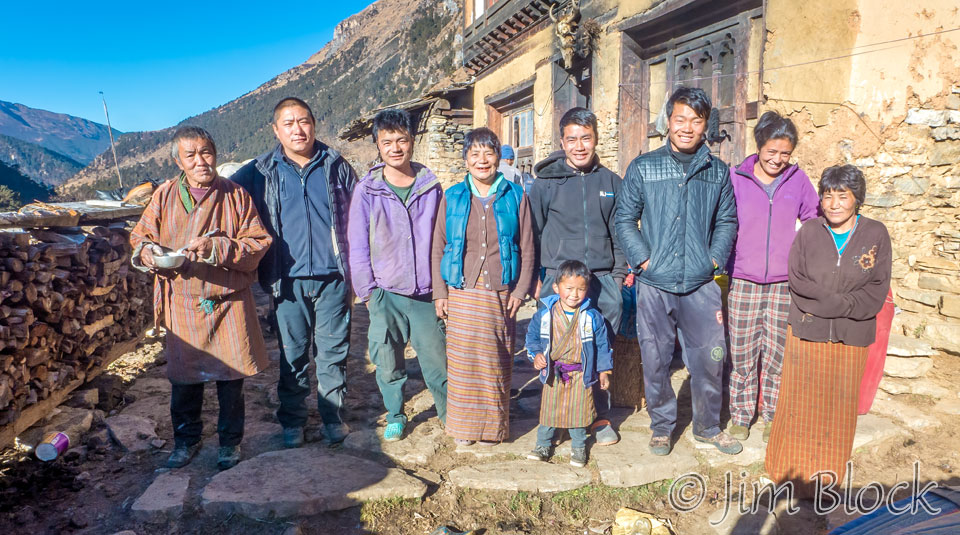

Finally we were off. Staying with the nomads was an experience I will remember for the rest of my life, a real highlight of the trek. You can see the top of their house in the distance near the center below as we headed south down the Dhumzo Chhu valley.
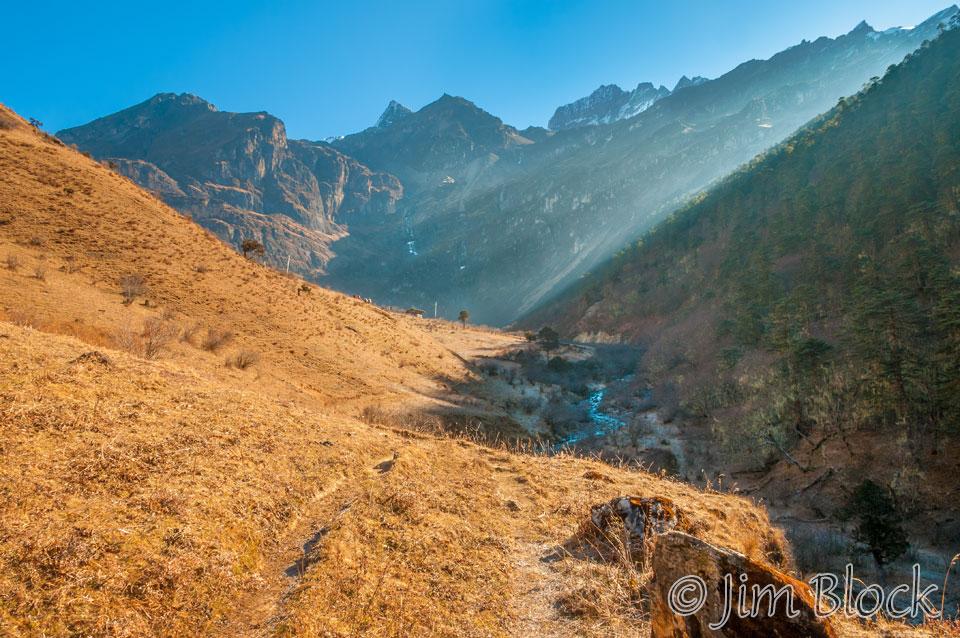
We crossed the river and followed it down the valley for quite a while. But we would soon be climbing again, up 2500 ft to another pass, this one at 14,829 ft.
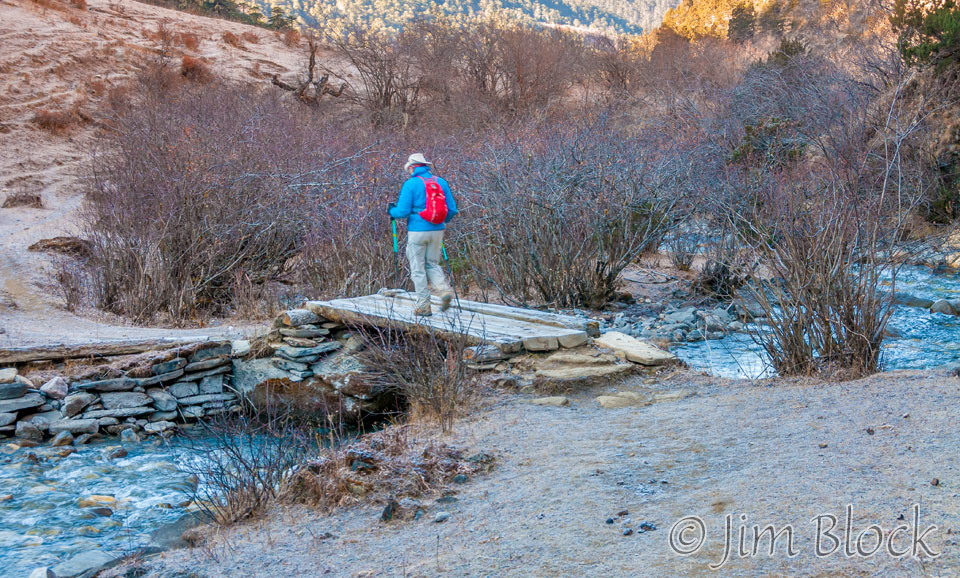
I found the trees fascinating, this one with a pair of ravens. Soon we would be above tree level again.
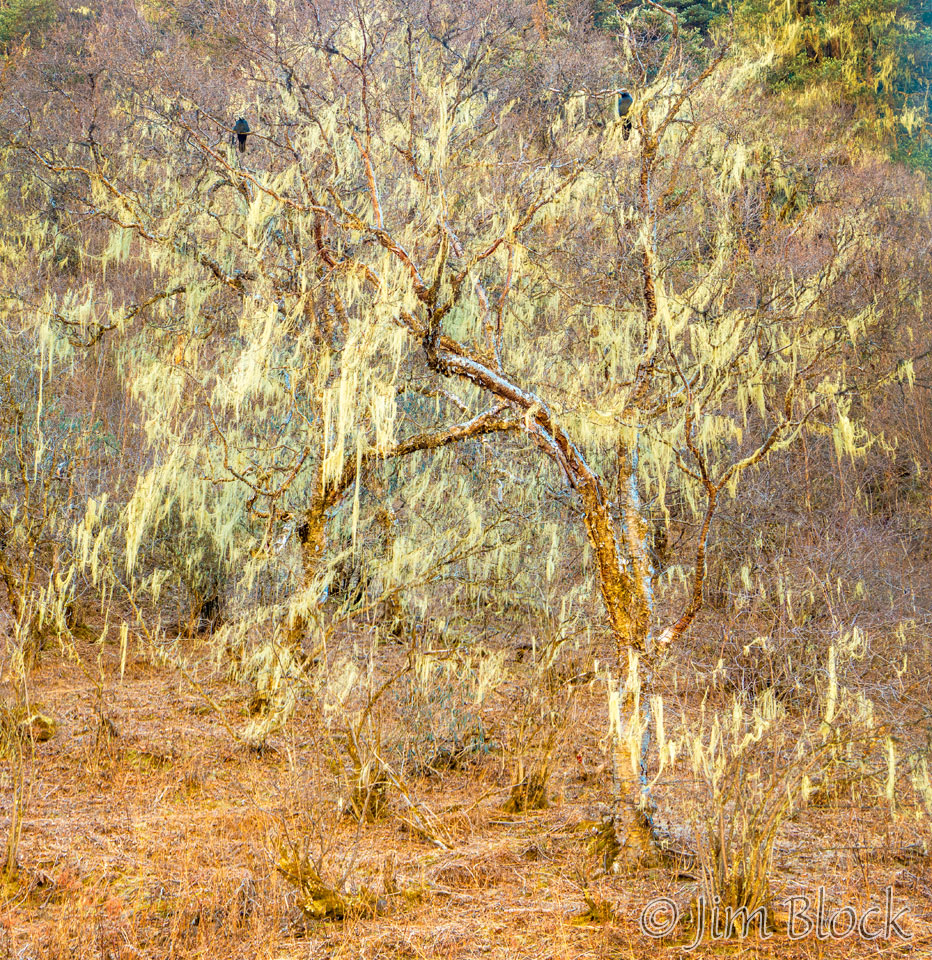
Our crew of a horseman, two assistants for the cook and Phub, and 7 horses caught up to us early this day. They did not have any tents to take down. For much of the morning our cook walked with us.

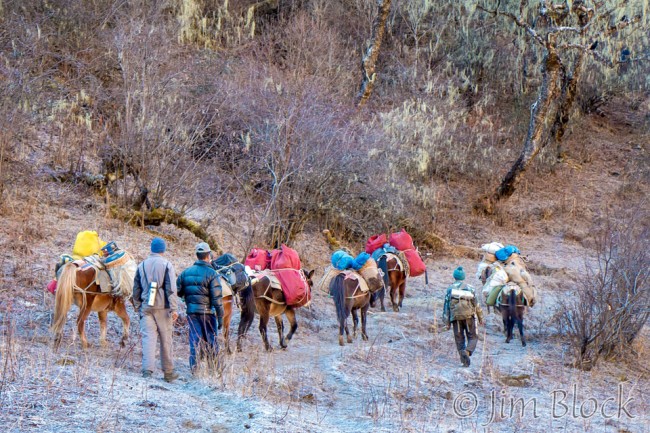
We started climbing, but not steeply yet. I photographed another interesting tree.
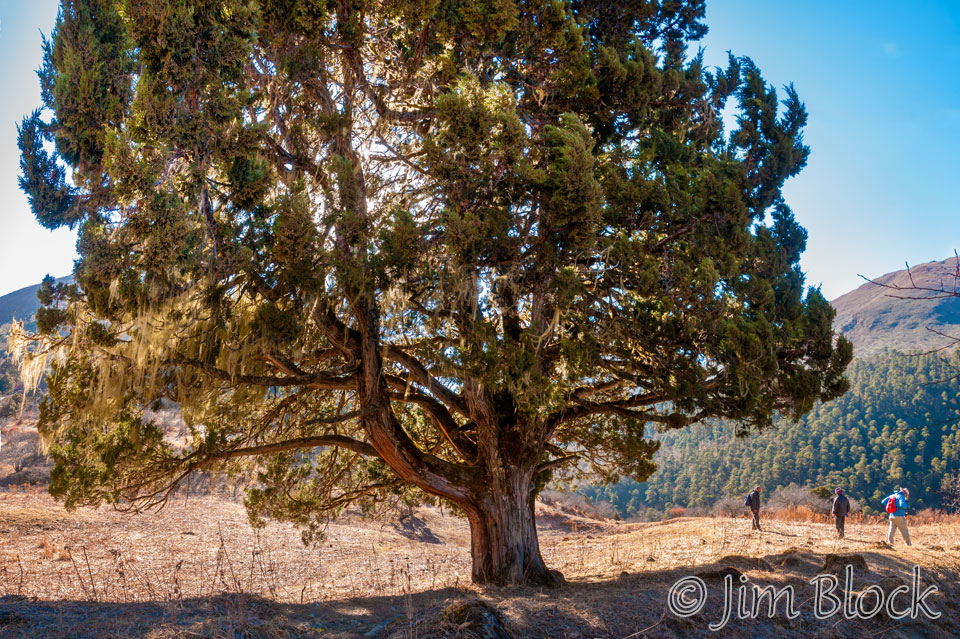
After climbing gradually for an hour we found ourselves heading downhill to cross another river. It is discouraging to lose altitude when you know the day’s mission is to cross another high pass.
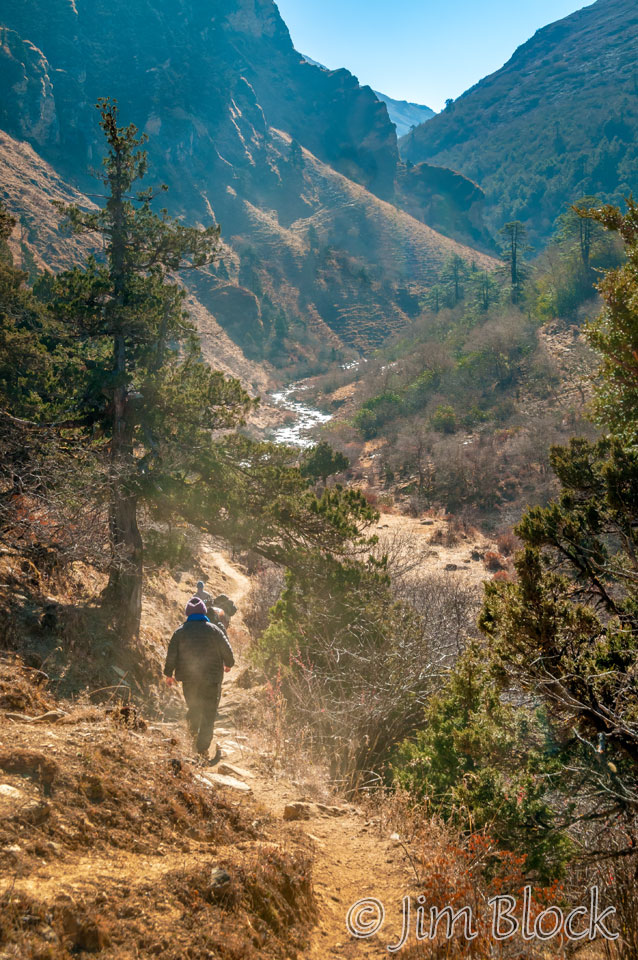
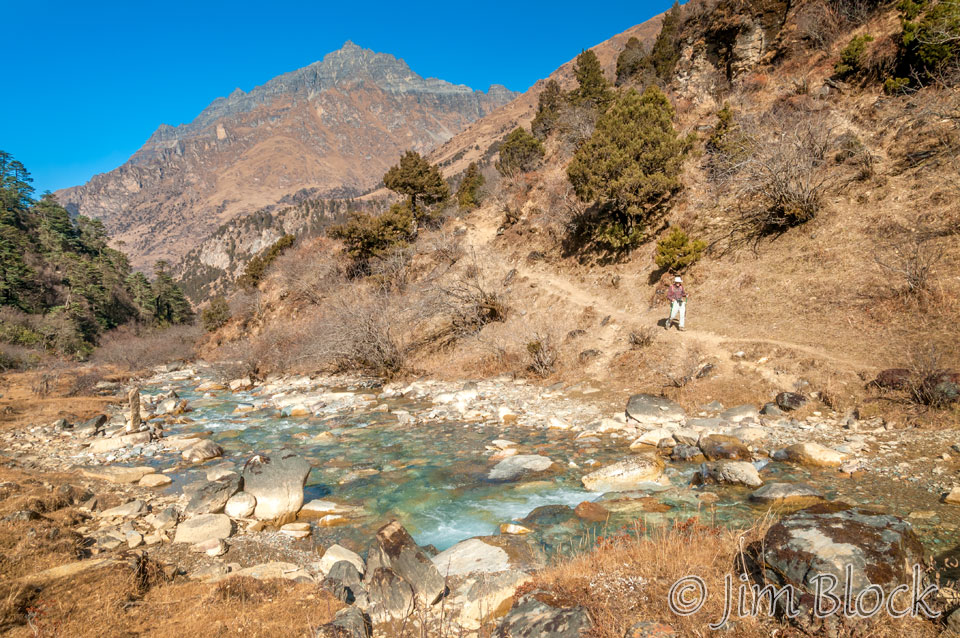
As we climbed more steeply now out of the valley, we could see scattered compounds far below us.
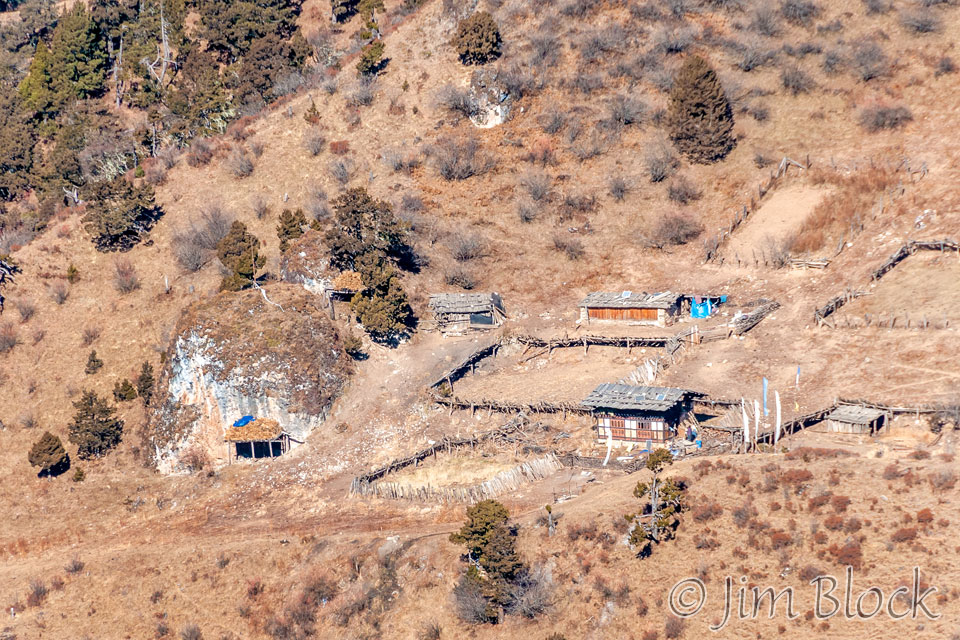
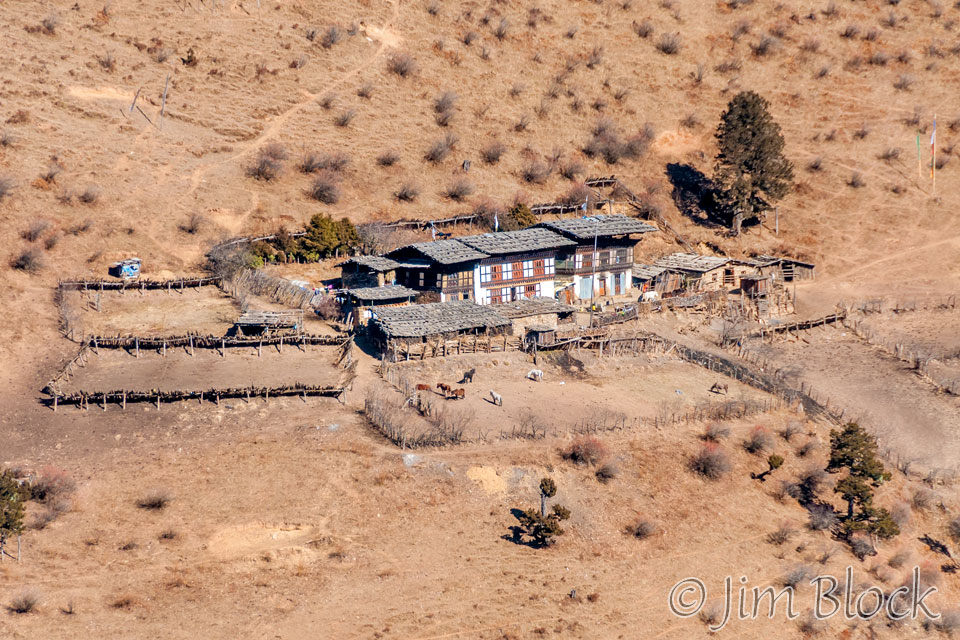
The view below is to the west across the valley. The compounds in the photos above are on the hillside in the middle of this photo. At the top left you can see our trail. Where the trail meets the ridgeline there are a group of prayer flags.

Here we are just above the prayer flags. Unfortunately they marked the beginning of a long gradual descent — when we really needed to be going up.
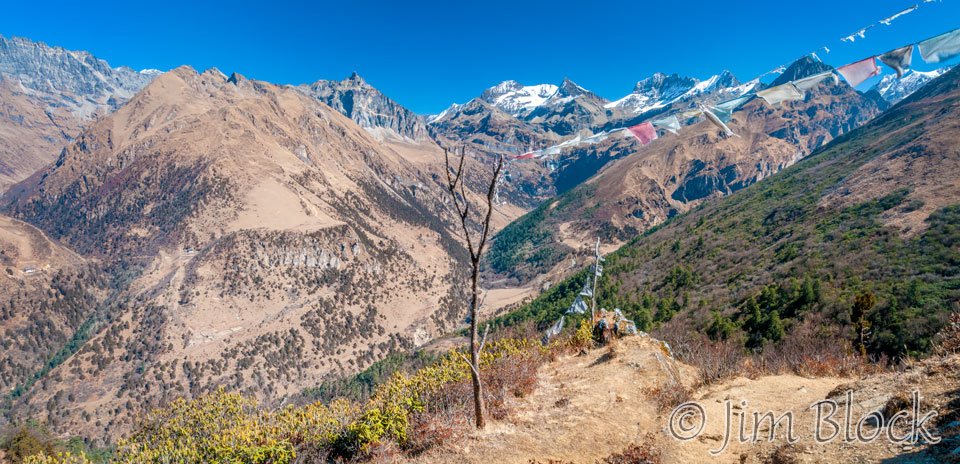
Phub lamented the erosion on the hillside due to loss of vegetation from overgrazing of yaks.
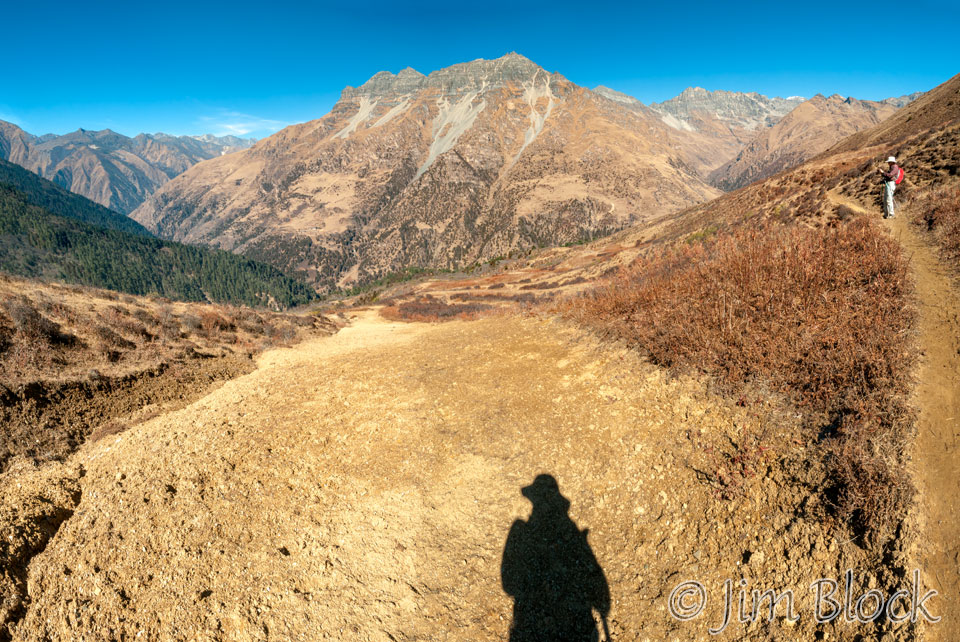
About an hour later, at noon, we were down on a partly-dry river bed. This was fortunately our last downhill section before the pass.

We are climbing again. You can see the river bed we crossed 20 minutes earlier in the distance. We came from behind that big hill from the right.
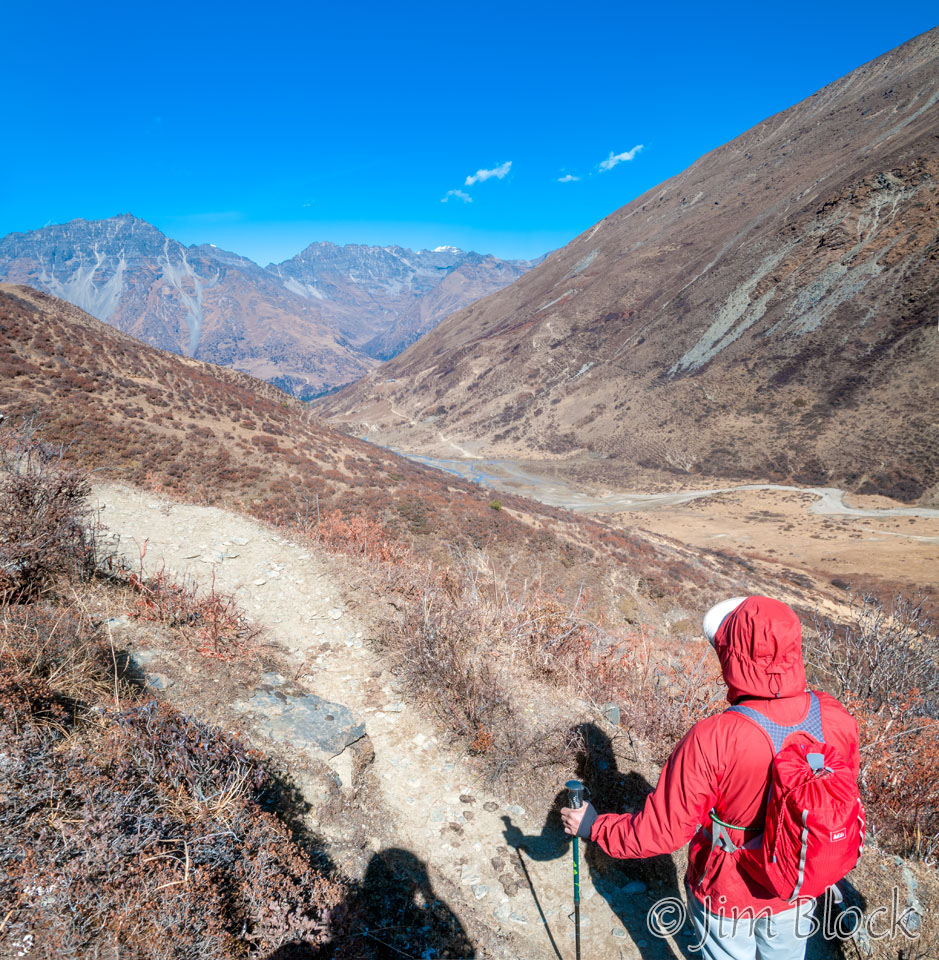
We climbed considerably then stopped for lunch at about 1 PM near a stone nomad house.
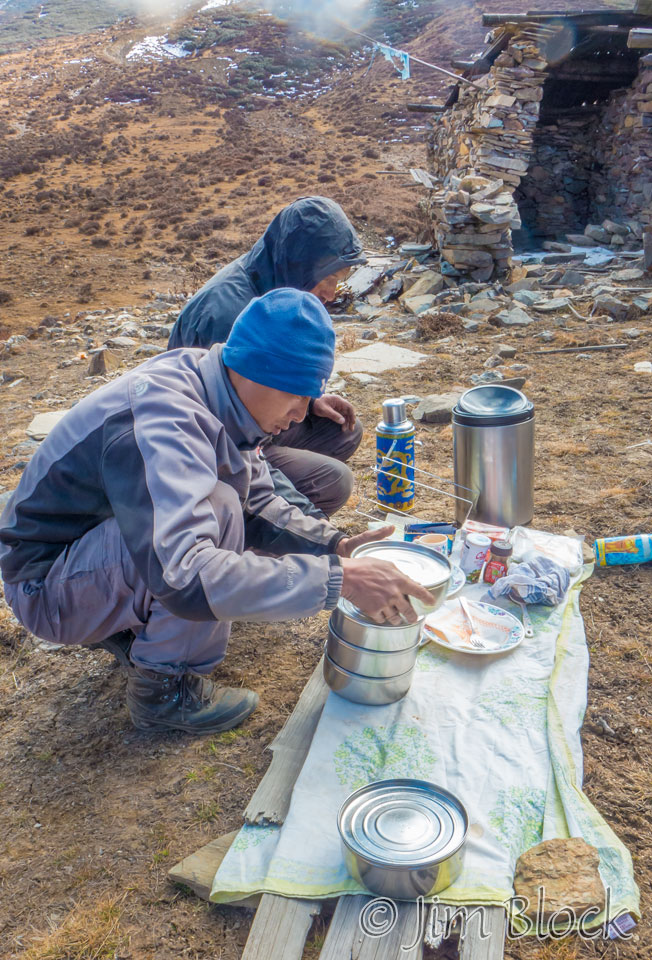
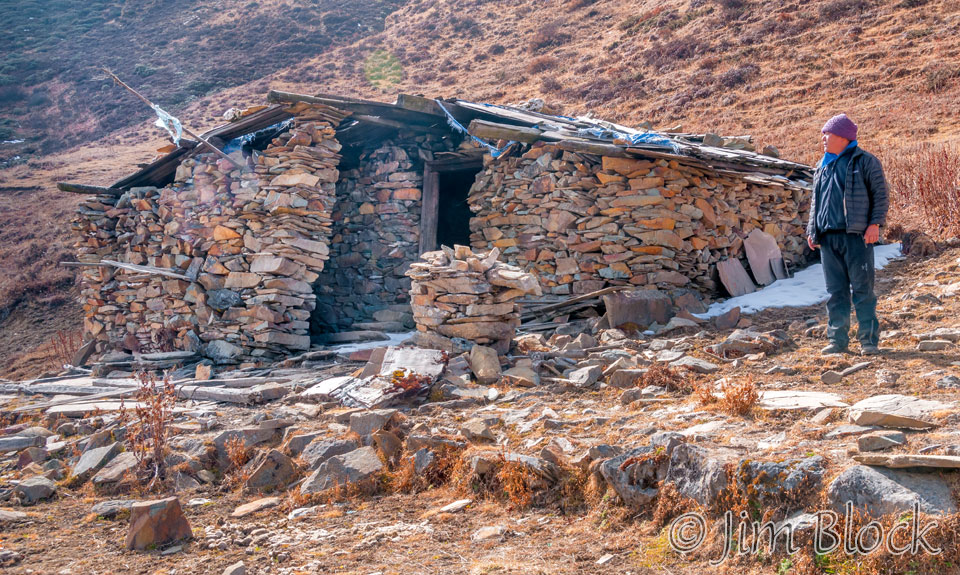
Here we are gaining altitude and are above tree line. You might be able to see the nomad house where we had lunch in the distance to the right of Phub’s head. To the right of Stephen and a long way down is the river bed we crossed 80 minutes earlier.
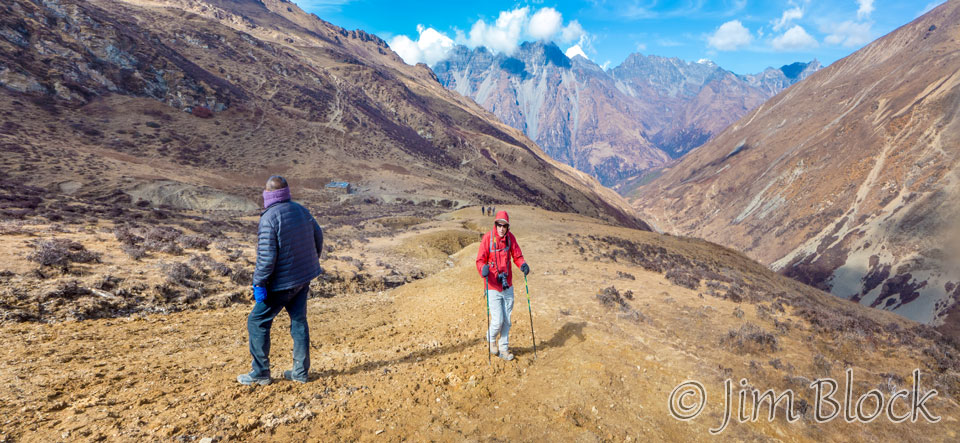
Finally we gained enough altitude that we could see over the mountain range to the the west and spot Jomolhari. It is the snow-covered peak to the far left in the photo on the left below.
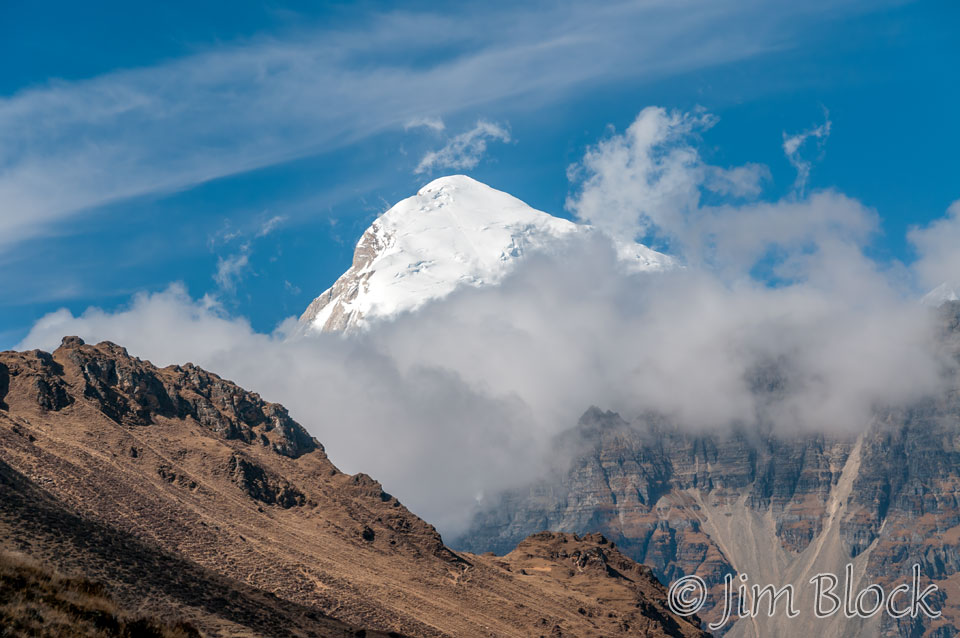
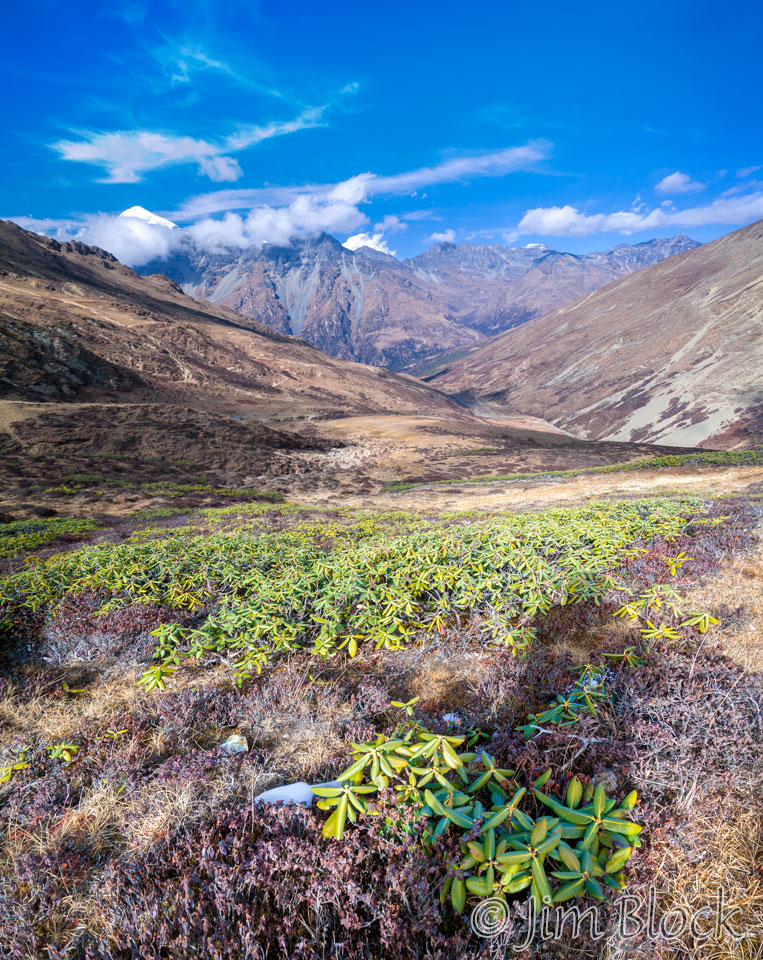
Looking ahead I saw prayer flags. The pass at long last, I thought. But some cruel trickster had put them there to fool us, or maybe for some other reason. We still had quite a bit more climbing to do. Phub said that the snow here is left over from the freak October snowstorm that killed many in the Thorung La region of Nepal.
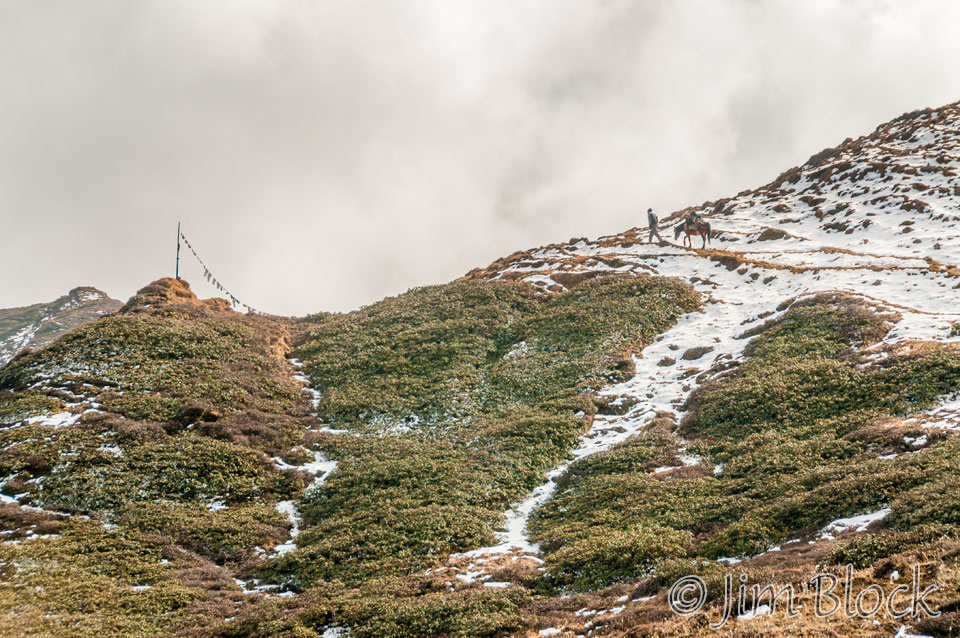
The photo below is a view from above of the “false pass” with the prayer flags.
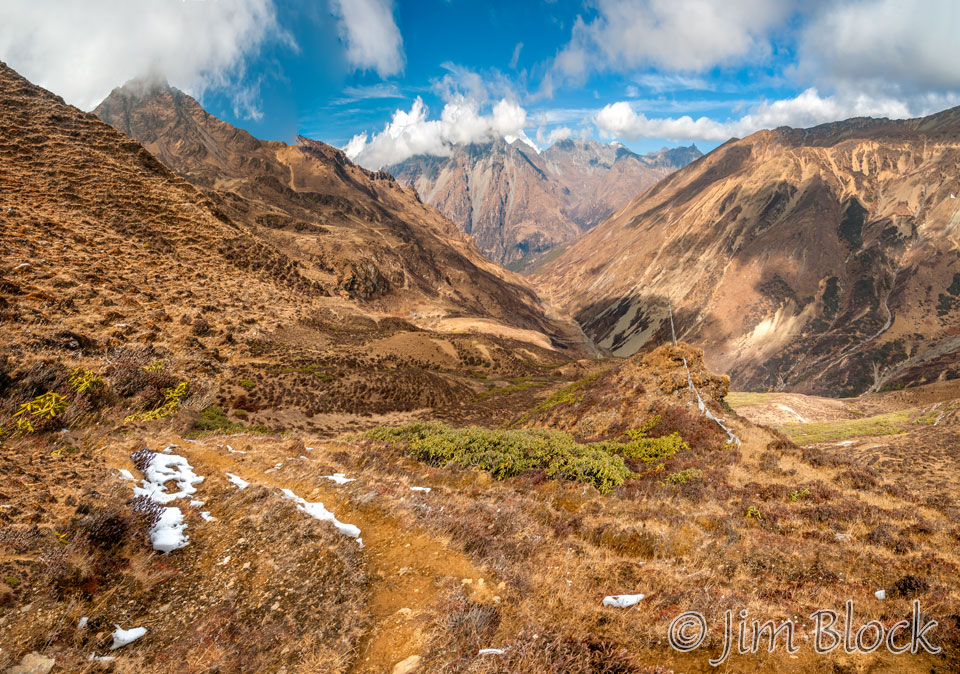
Here is Stephen drudging upward to Takhung La (the real pass finally). In the telephoto photo on the right taken 10 seconds after the left photo you can see someone sitting at the pass under an umbrella, although he was gone when we arrived.
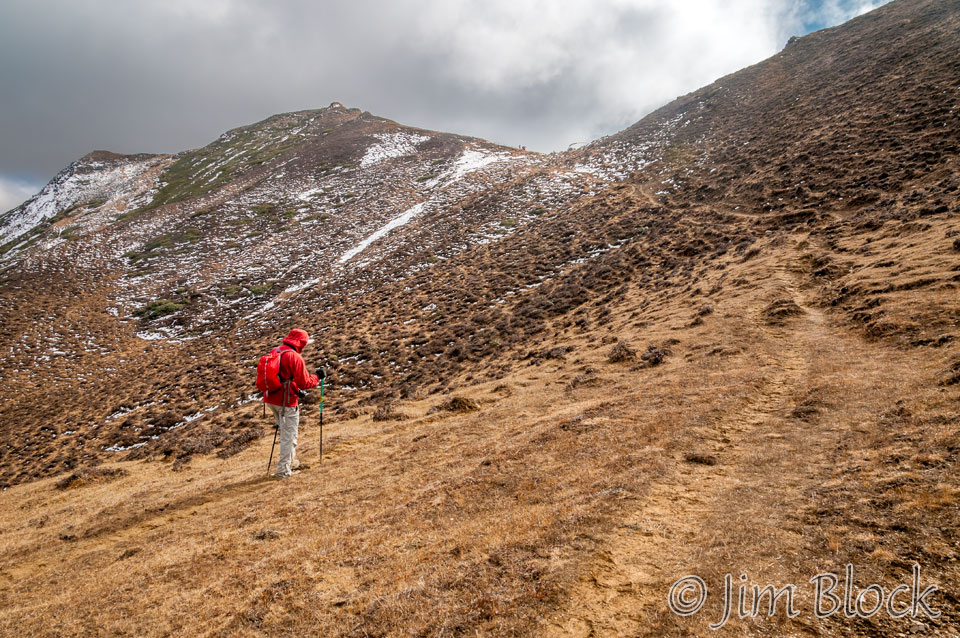
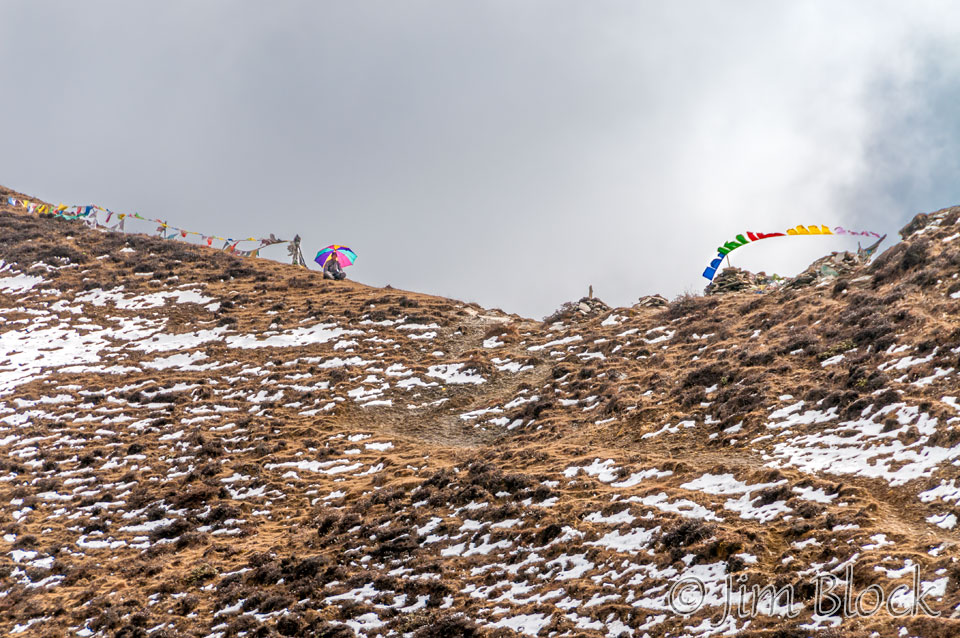
It was a cold and windy climb to Takhung La. Two down, one more high pass to go.

Phub took a photo to prove we were there. That is Mount Jomolhari between us. Notice how I cleverly stood uphill to make it look like I am taller than Stephen.
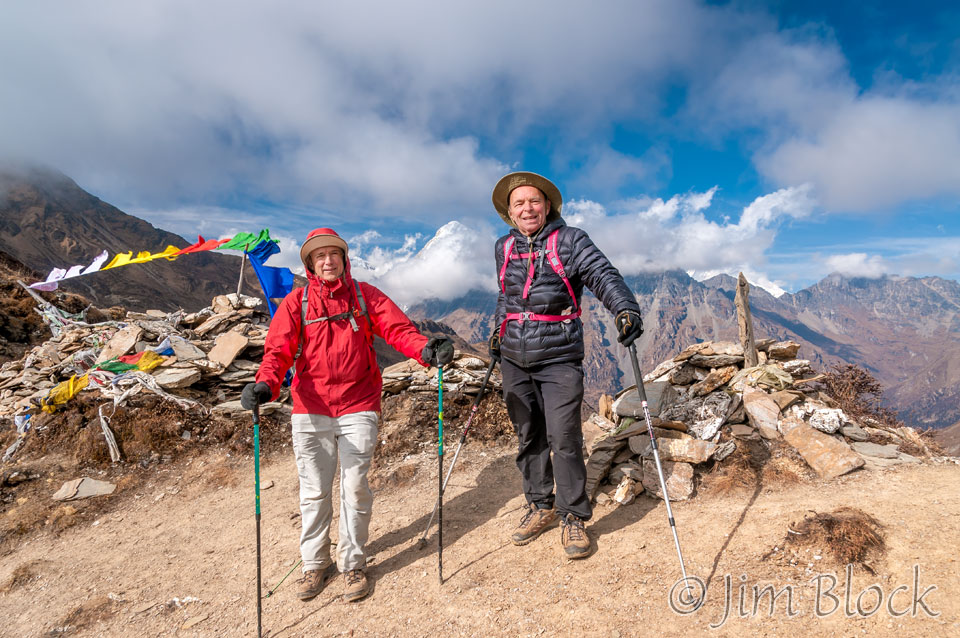
From the pass I took some photos looking ahead, to the south. I didn’t know what I was seeing, but I do now. Our camp for the night is near the center of this photo. Our pass for tomorrow is near the left end of the ridgeline near the top of the photo. No, we do not go down the valley to the left. That might be too easy, or maybe it would take us to the wrong place.
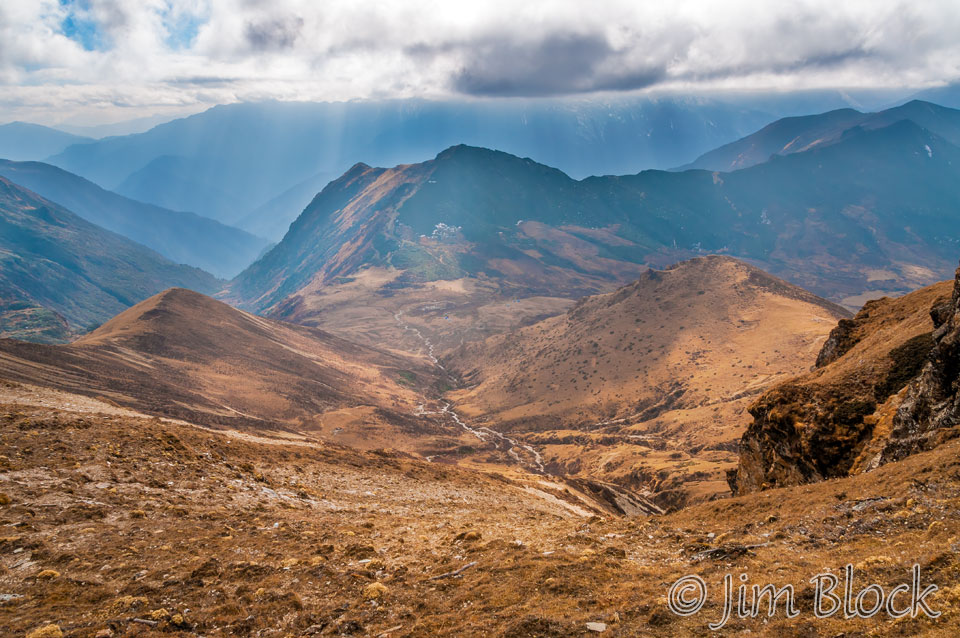
Here is a 13-shot panorama from just below the pass. Takhung La is at the top right corner. If you zoom in you can clearly see the prayer flags marking the pass. Phub and Stephen are ahead of me heading down. Our camp for the night is in the valley near the middle of the image. If you zoom in you can see our three blue tents. The pass for tomorrow, Thombu La, is left of center along the ridgeline.
You can double click on the image to zoom way in and use the left mouse to pan around. You can also use the + and – keys to zoom and the arrow keys to scroll. Please wait for the resolution to download.
Ten minutes later, this was our view. You can see our blue tents down on the plain to the right of the nearby hill. You can likely also pick out the trail up to our next pass, Thombu La.
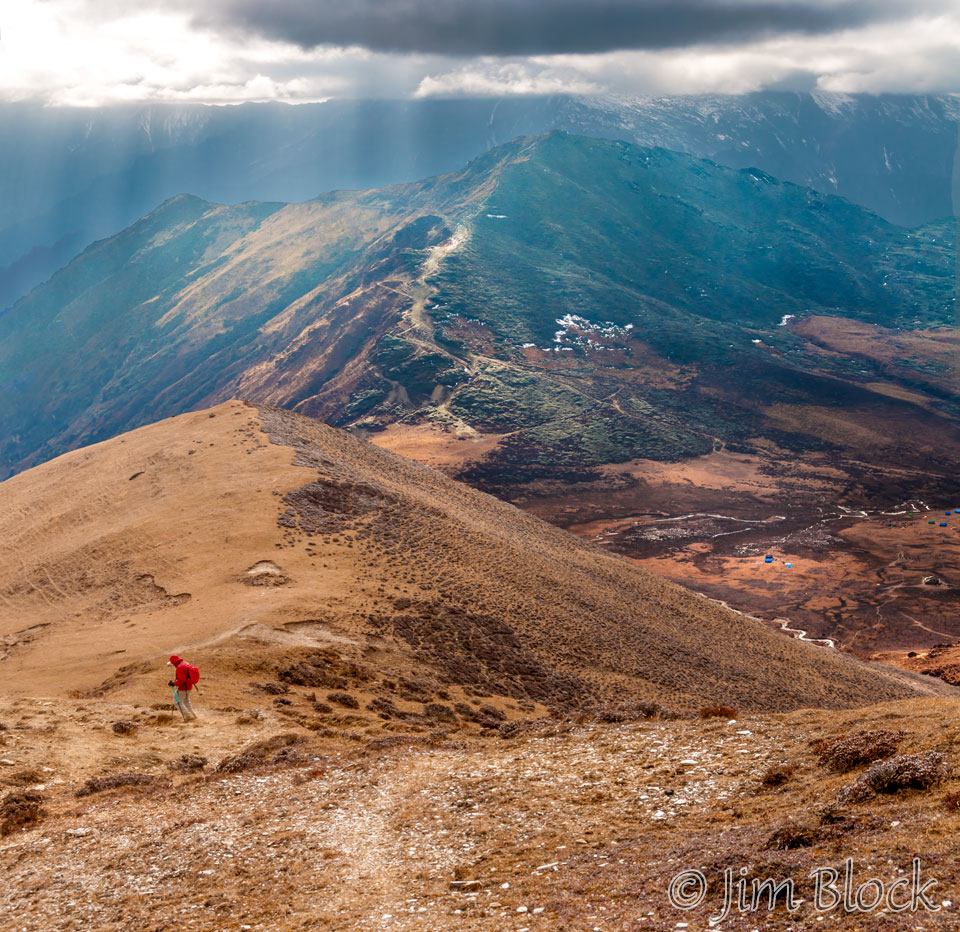
Here are three labeled images of our camp at Thombu Shong and the Thombu La (pass at 14,370 ft) as we descended to camp. These photos were taken 15 to 20 minutes after the one above.

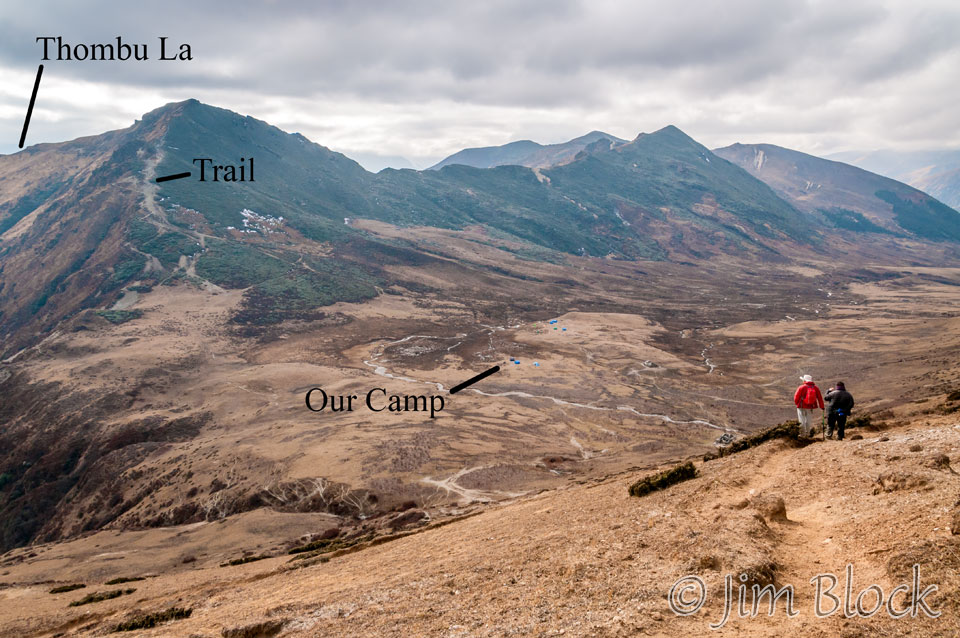
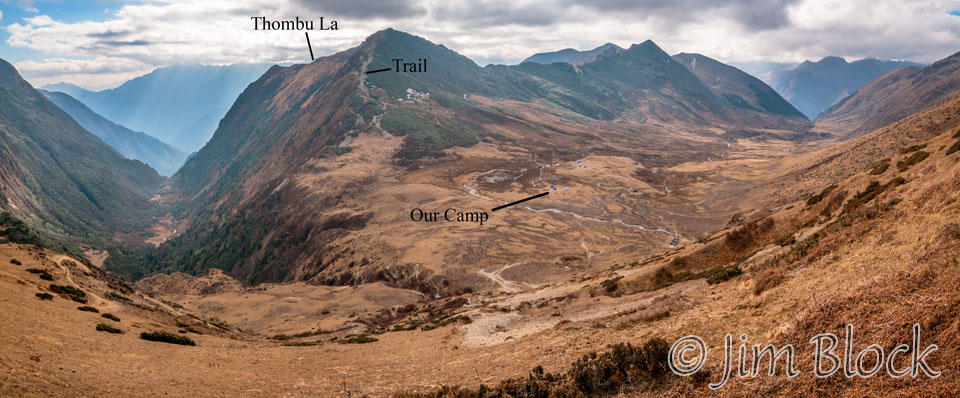
It was all downhill from here. Except for the climb to the pass tomorrow morning.
Nearing our camp site we saw a pretty marginal nomad shelter, then a nomad hut in a bit better shape.
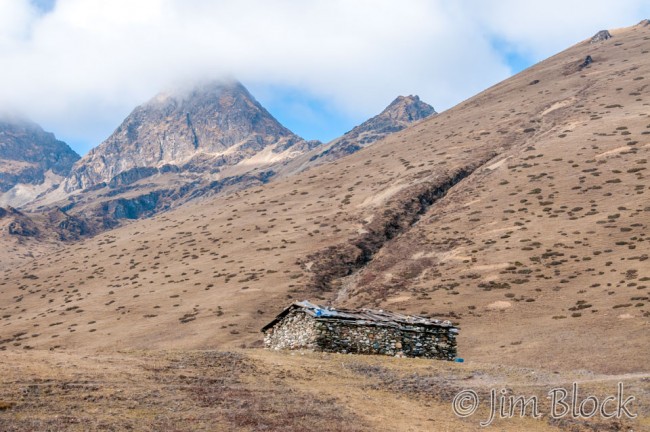

Here are Stephen and Phub inspecting the nomad hut. There is one item that is useful to us in this room. Can you spot it?
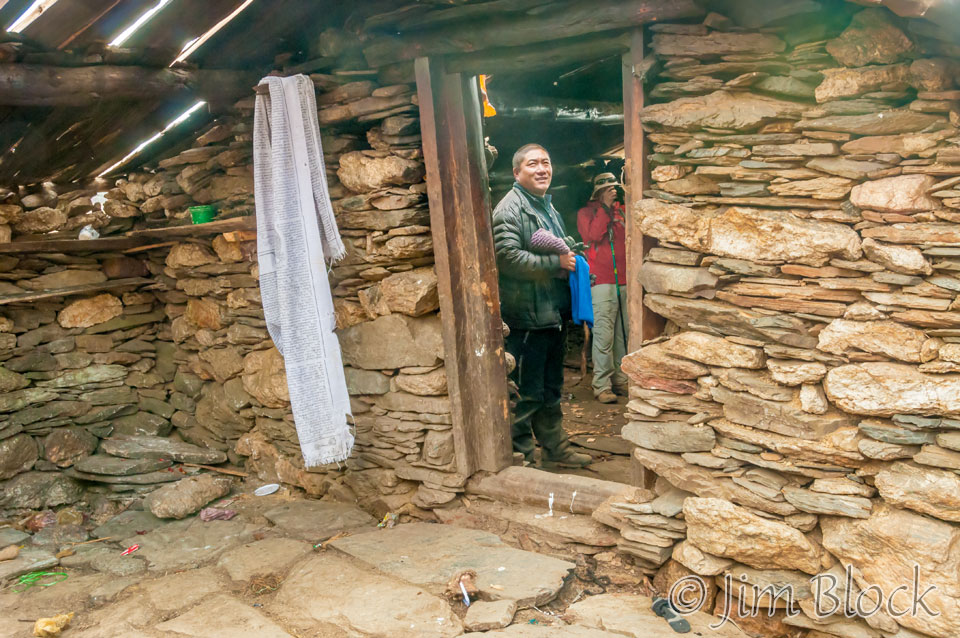
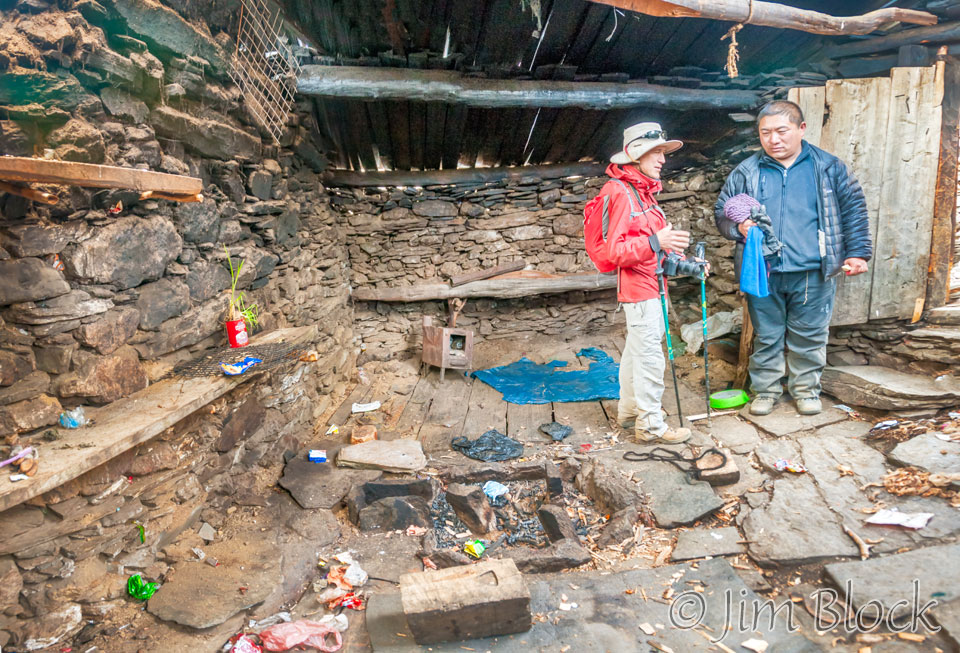
Below are two views of the pass we crossed 90 minutes previously. In the left photo the pass is directly above the center horse. Behind the two horses on the right is the mostly-collapsed nomad shelter.
The photo on the right shows a closer-up view of Takhung La.
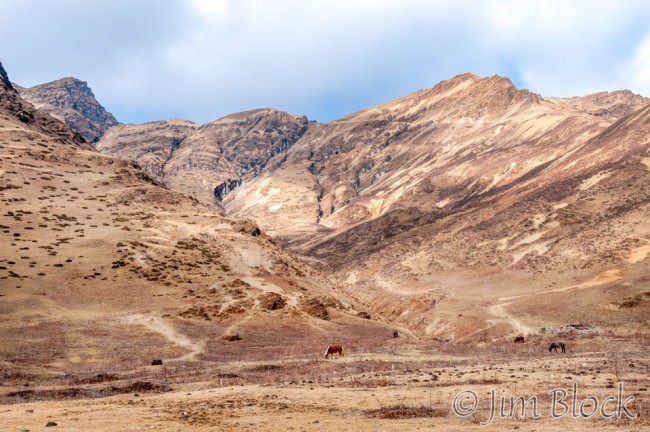
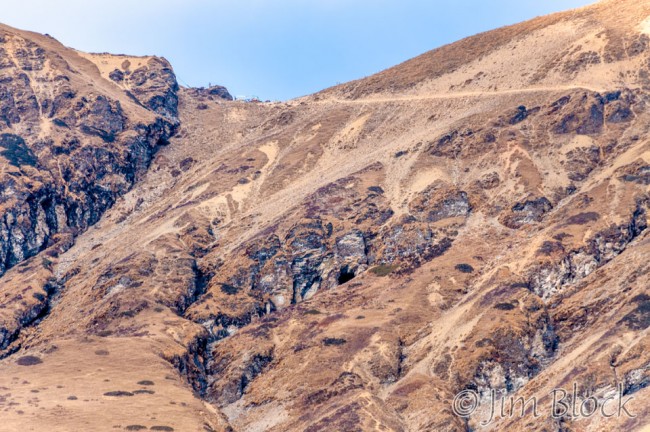
Here is our camp site in the plain that is Thombu Shong. Phub tells me they were considering an airstrip here. He said it would have to be built with hand labor — there was no way to get a bulldozer in here. (The Bhutanese seem to be very afraid of helicopters so I guess that option was not considered.) The plans were abandoned when there was yet another crash at Lukla in Nepal even though this would be a safer place to land than Lukla. Glad the airstrip didn’t get built because it would spoil a beautiful area.
You can double click on the image to zoom way in and use the left mouse to pan around. You can also use the + and – keys to zoom and the arrow keys to scroll. Please wait for the resolution to download.
In the pan above, if you look just above my orange towel hanging on our tent you can see our trail down from the Takhung La pass. The pass is where the trail ends to the left. On the right side of the photo is our dining tent and the smaller cook tent. Directly above the front peak of the cook tent is Thombu La the 14,370 ft pass we will cross tomorrow. You can zoom in and see the prayer flags there.
Behind our luxurious tent you can see a nomad house that our crew appropriated a stove from and then returned it the next morning. The toilet tent is our of sight to the left. Note the table for tea and snacks and the washing bowl and soap on the ground.
At 4 PM we had French fries and toasted cashews.
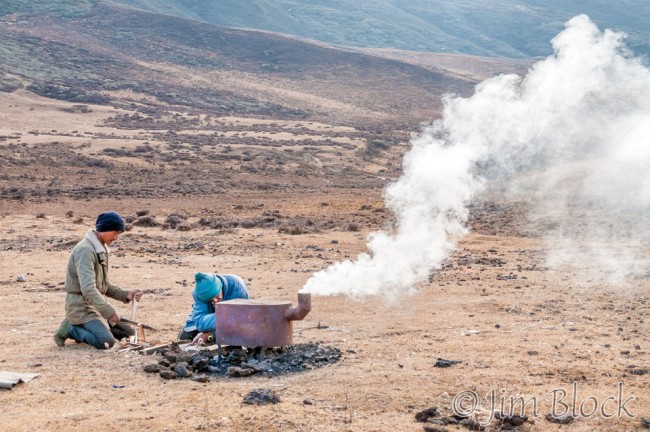
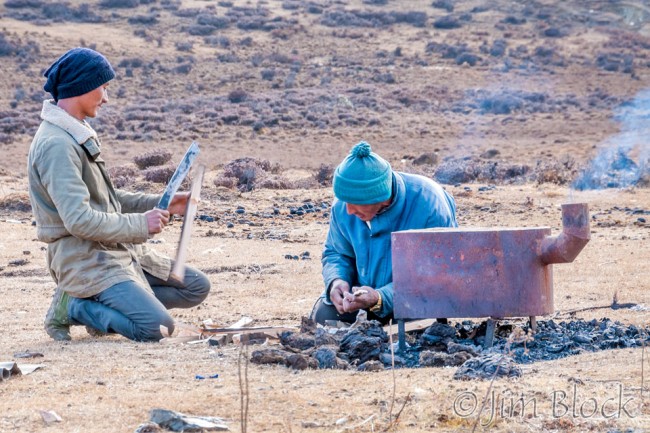
Dinner tonight will be Smoked Stephen. At this point the stove is burning mainly yak dung.
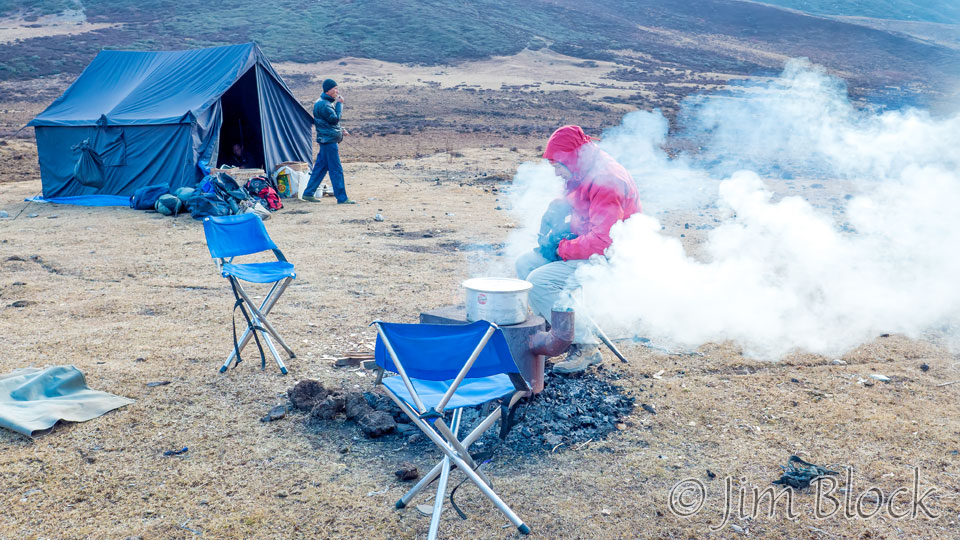
Once our crew proved they could get the stove started and keep it going, they got it really hot then decided to carry it into the dining tent. This might be our dining room, but it is their bedroom and they were thinking ahead. This was to be the coldest night of the trek. Not having enough yak dung to burn the horseman went out to collect some wood.
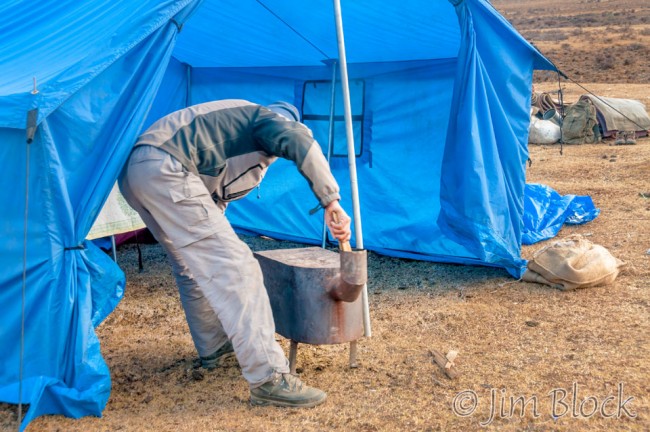
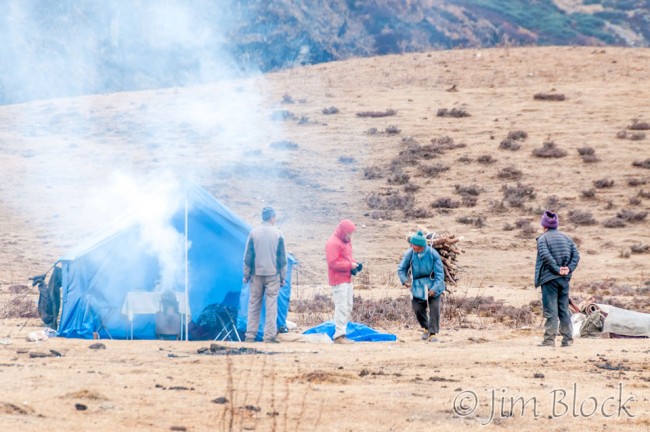
Stephen made a video of the crew with his iPhone. The horseman was out gathering firewood so he is not in the video. I photographed Stephen making the video with my LX7. Here is a short segment.
[KGVID width=”640″]https://www.jimblockphoto.com/wp-content/uploads/2015/12/BHU-10364-short-video-UtubeSD.mp4[/KGVID]
The photo below shows Stephen playing his video back. He later added an interview with the horseman.
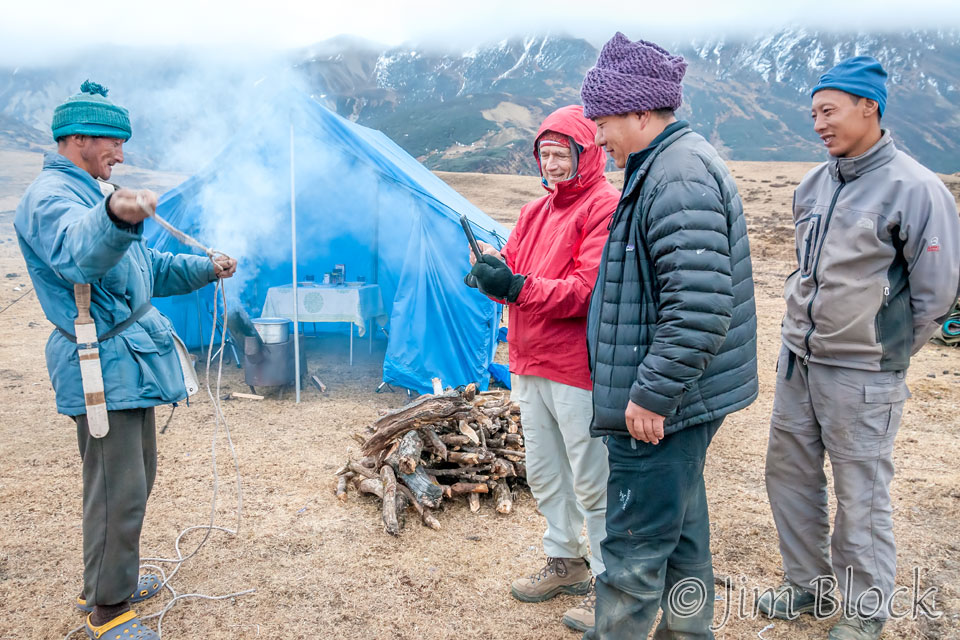
Dinner included excellent tacos. Here they are being prepared.
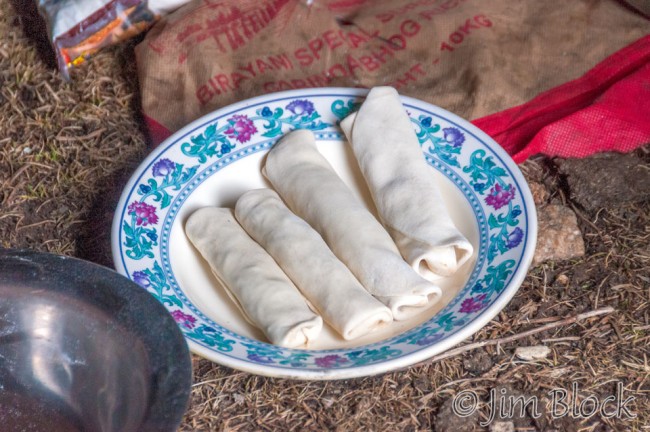
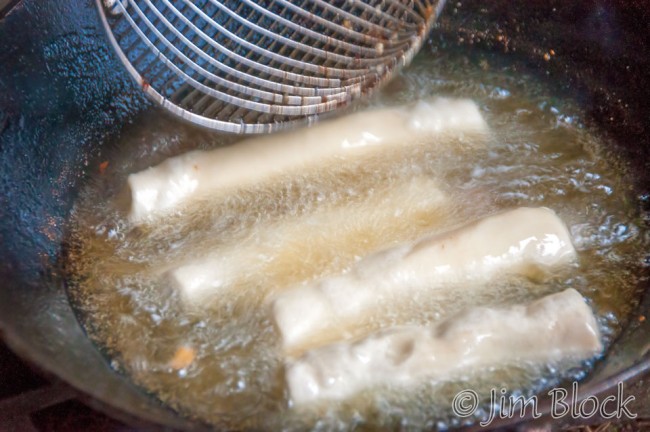
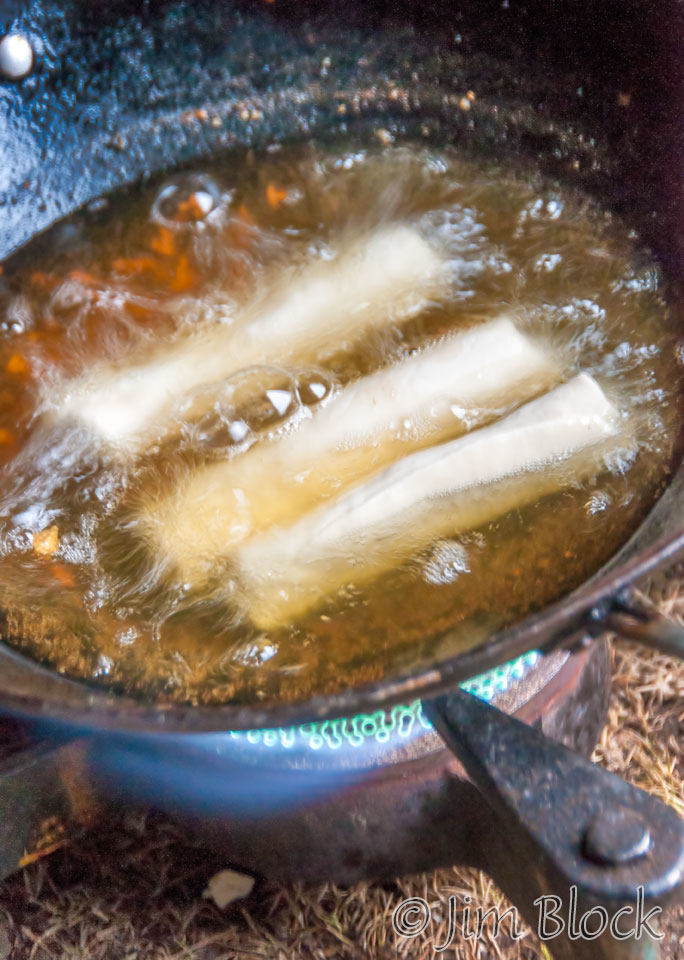
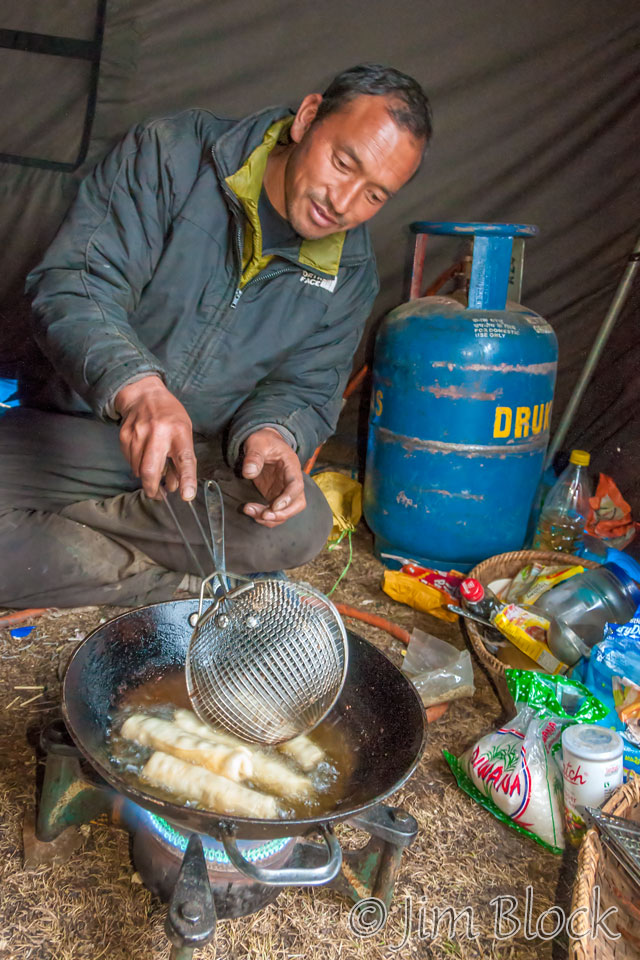
The tent was getting pretty smoky. So the crew borrow a stove pipe from somewhere. It helped considerably. Before dinner there were 9 people around the stove. Crew members of other trekking groups were attracted by the smoke. The crew kept the fire going all night.
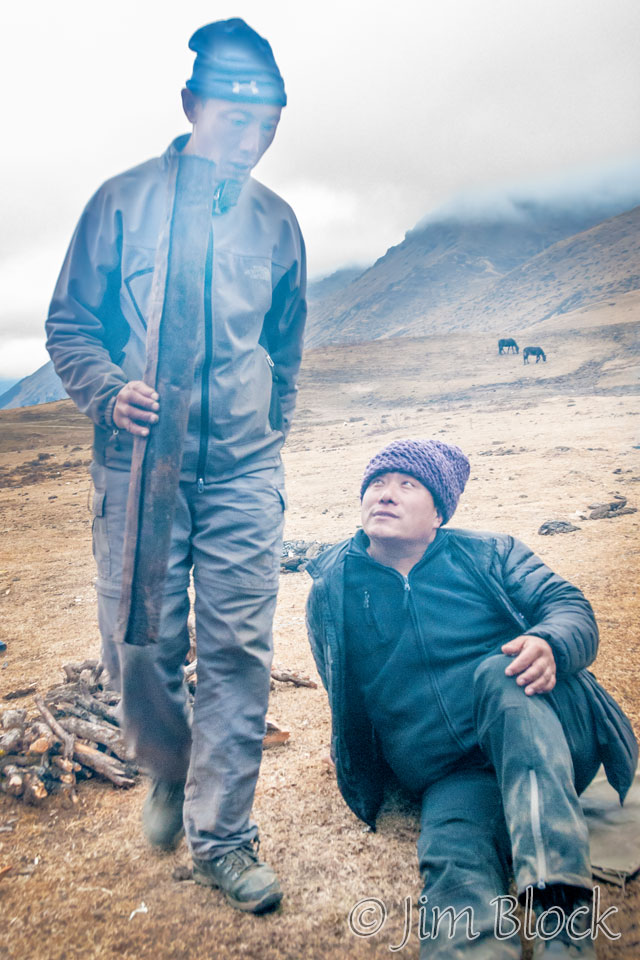
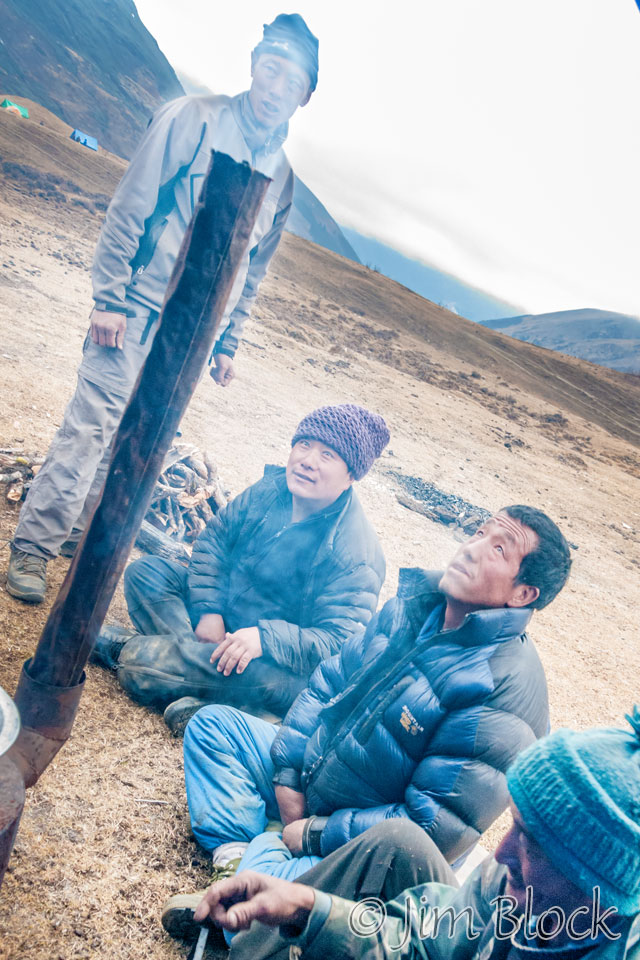
Below are some of the other photos from Day 5 of the Jomolhari Trek.

